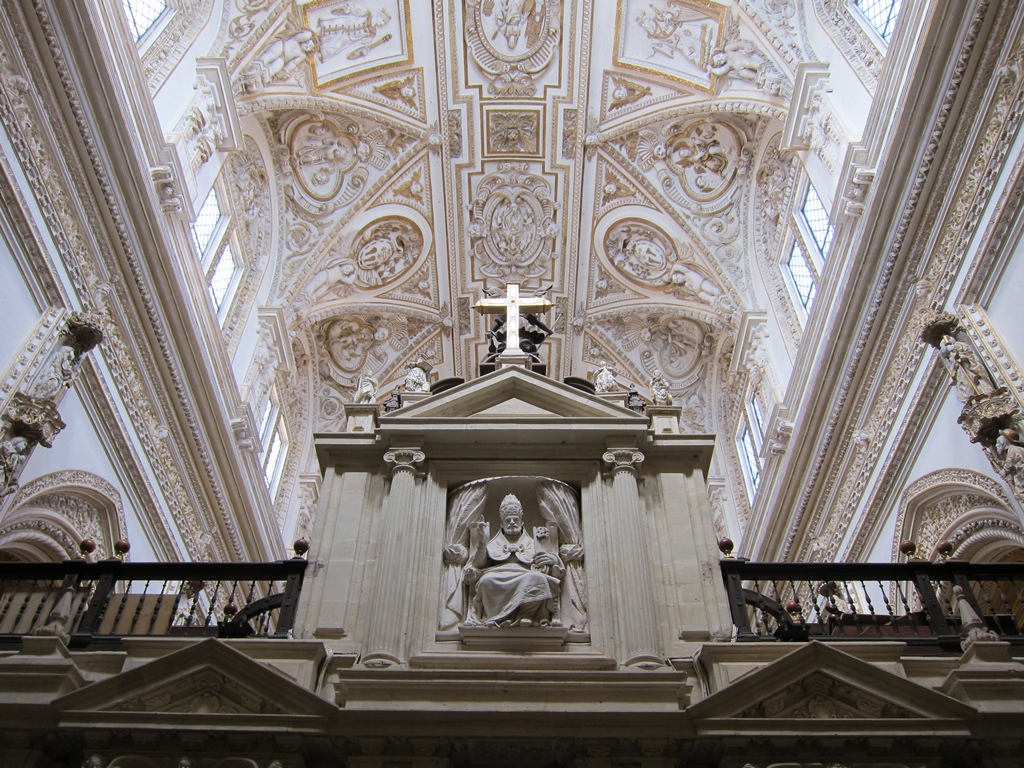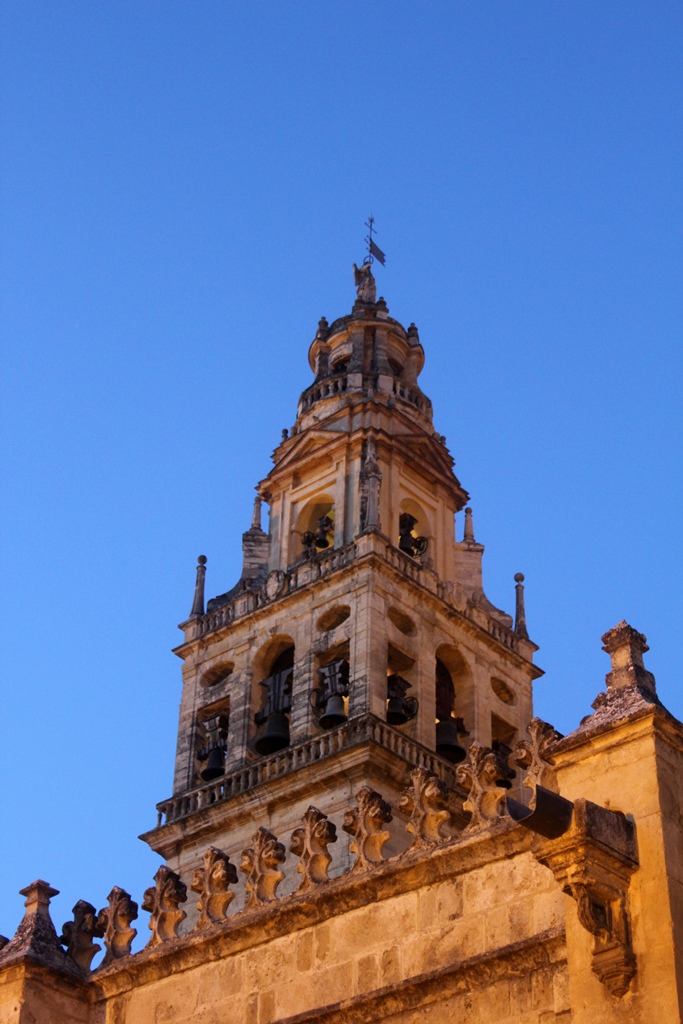The Great Mosque of Córdoba, built through considerable effort and expense by the Moorish
Umayyad dynasty, has not in fact been used as a mosque since June 30, 1236. It was on this
date that Ferdinand III of Castile took possession of the city, a day after its formal surrender
ended a siege by the Christian forces. One of the first tasks addressed on this day was the
consecration of the celebrated mosque as a Christian cathedral, now formally known as the
Cathedral of Our Lady of the Assumption. Islamic practices have not been allowed in the
Mezquita ever since, with requests to end this policy having been turned down by the Roman
Catholic Church on more than one occasion. The Catholics' point of view is somewhat
understandable – it's their church, and other religions should practice in their own
facilities (there are functioning mosques in the area). But there are area Muslims who remain
less than content with this situation.
During the Reconquista, the repurposing of mosques as Christian places of worship was a
fairly common practice. The same thing was done in Seville when it was captured twelve years
later. But the Seville mosque/cathedral eventually deteriorated to a point where it had to be
rebuilt, while the bulk of the Córdoba mosque was retained, with the help of appropriate
maintenance. And improvements were made in Córdoba, though of an unmistakably Christian
character. Which we discovered as we wandered through this rather schizophrenic building. Some
were on the subtle side, or architectural in nature.
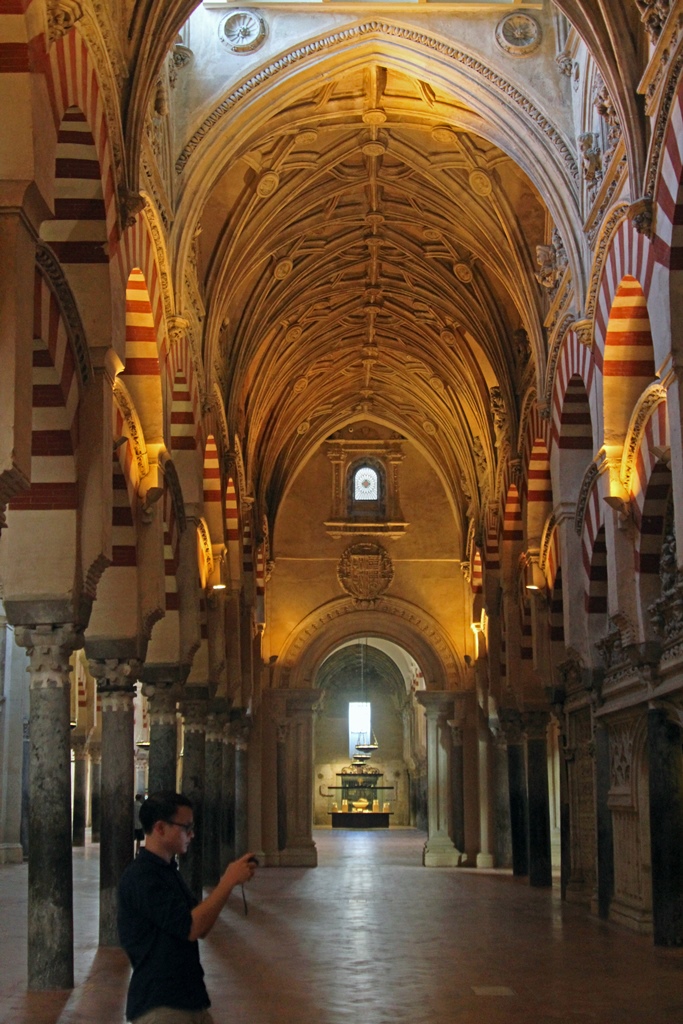
Philip in Gothic Corridor
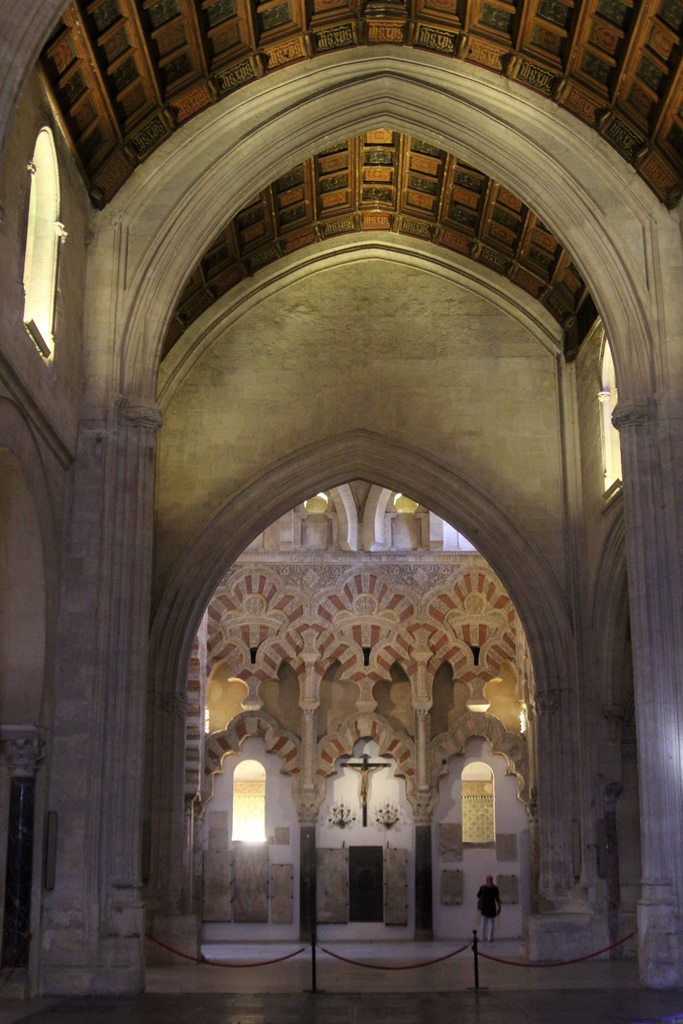
Villaviciosa Chapel
Other improvements were more overt. Sprinkled liberally among the Moorish arches are many
altars and Christian accents.
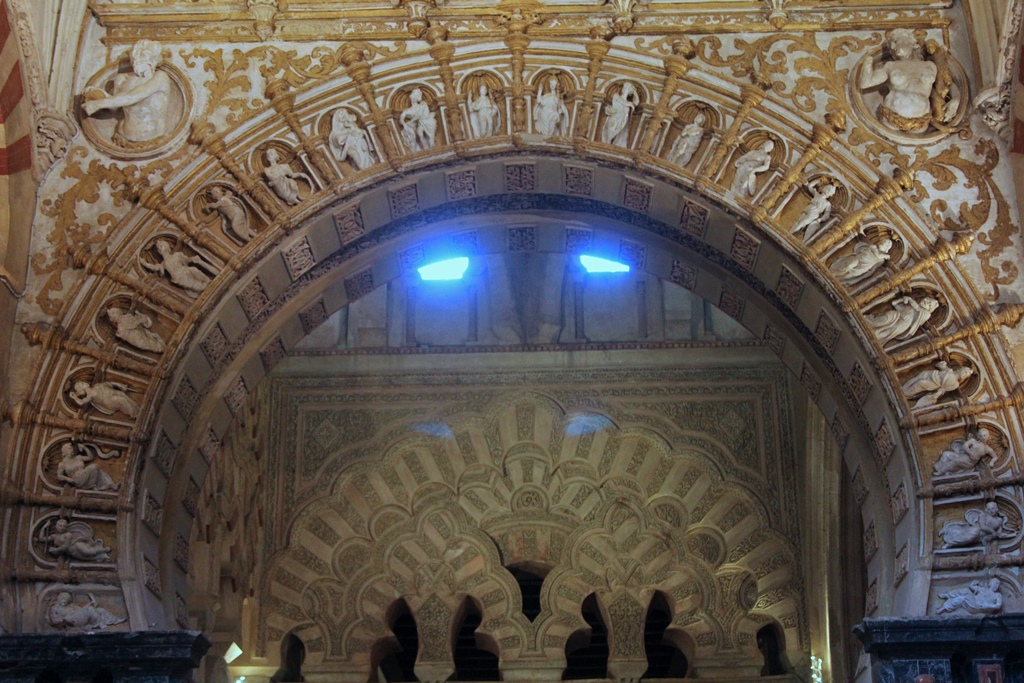
Christian and Moorish Arches
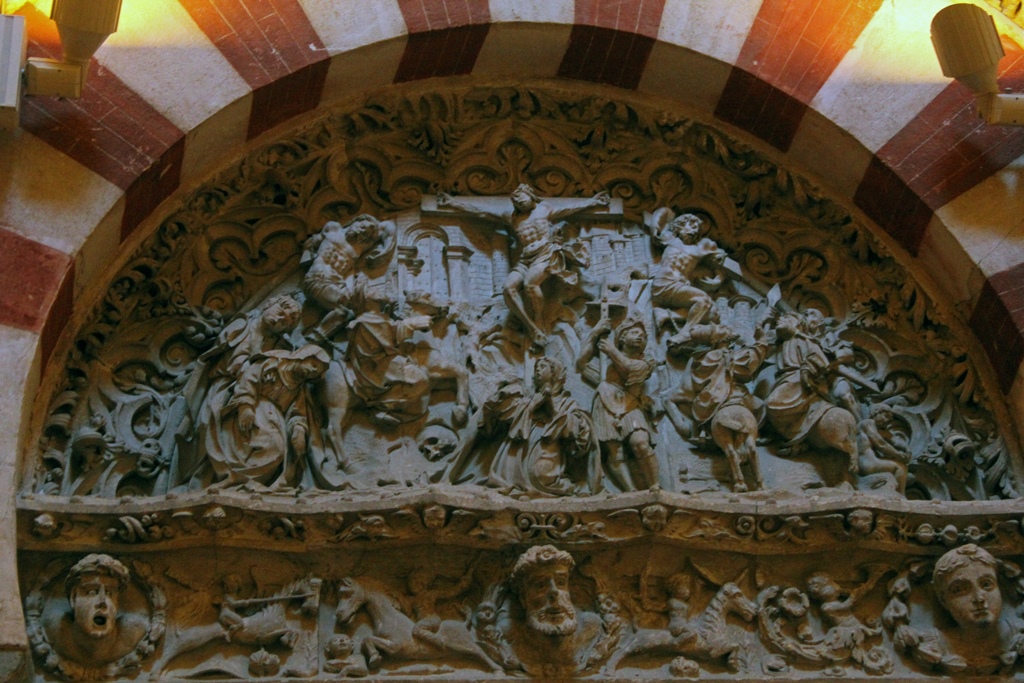
Crucifixion Relief in Moorish Arch
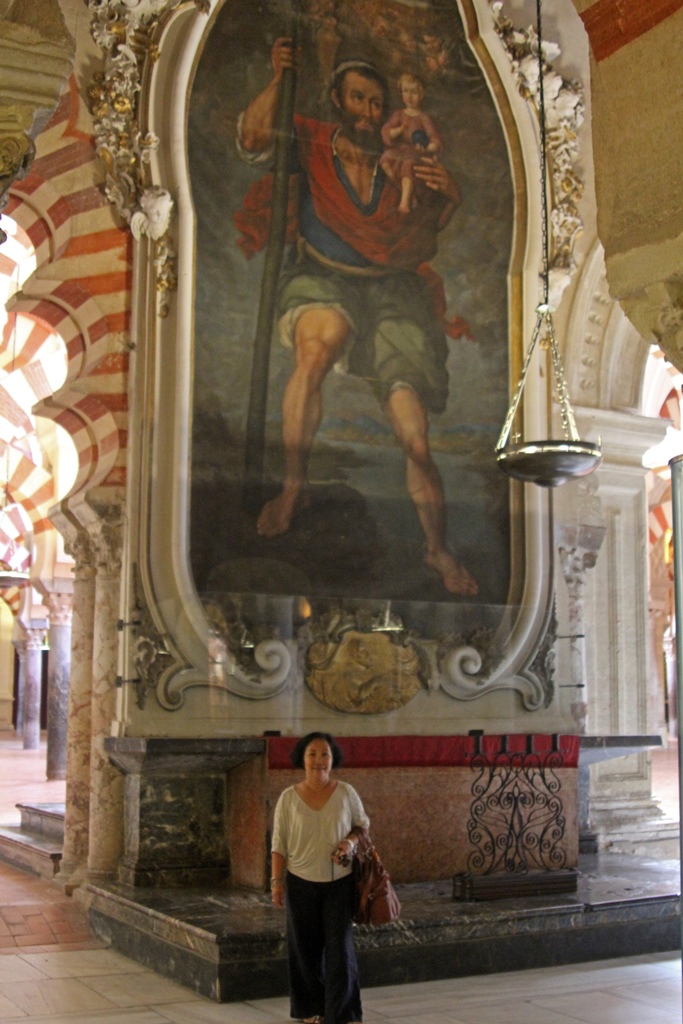
Nella and Altar of St. Christopher
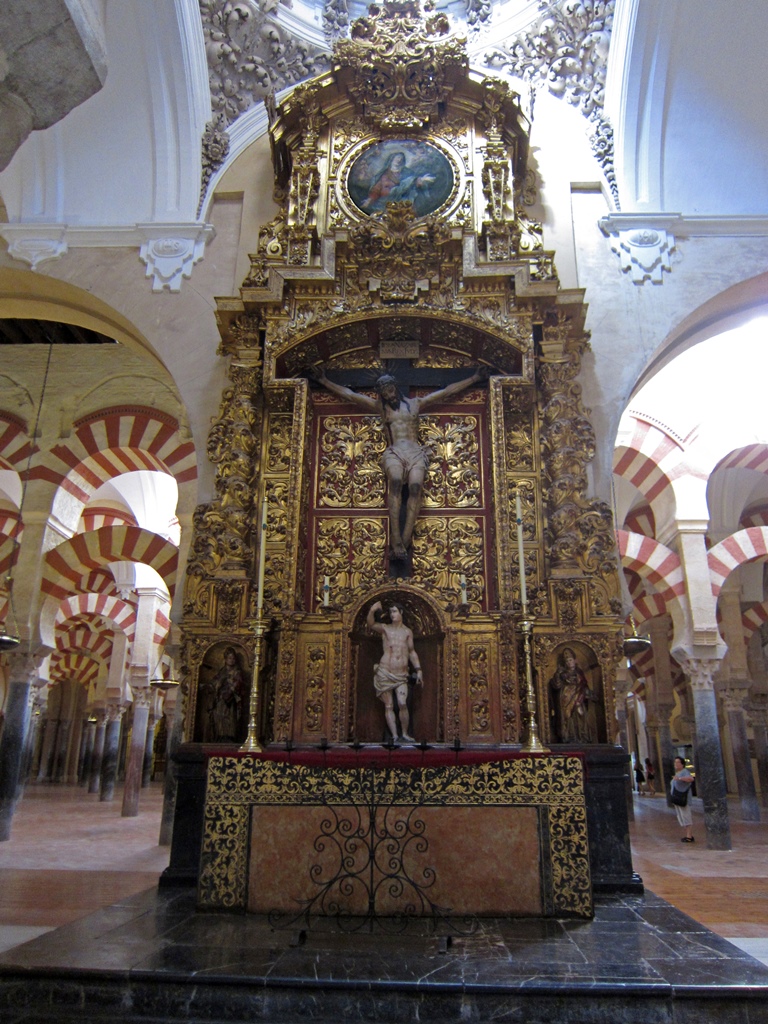
Altar of the Santísimo Cristo del Punto
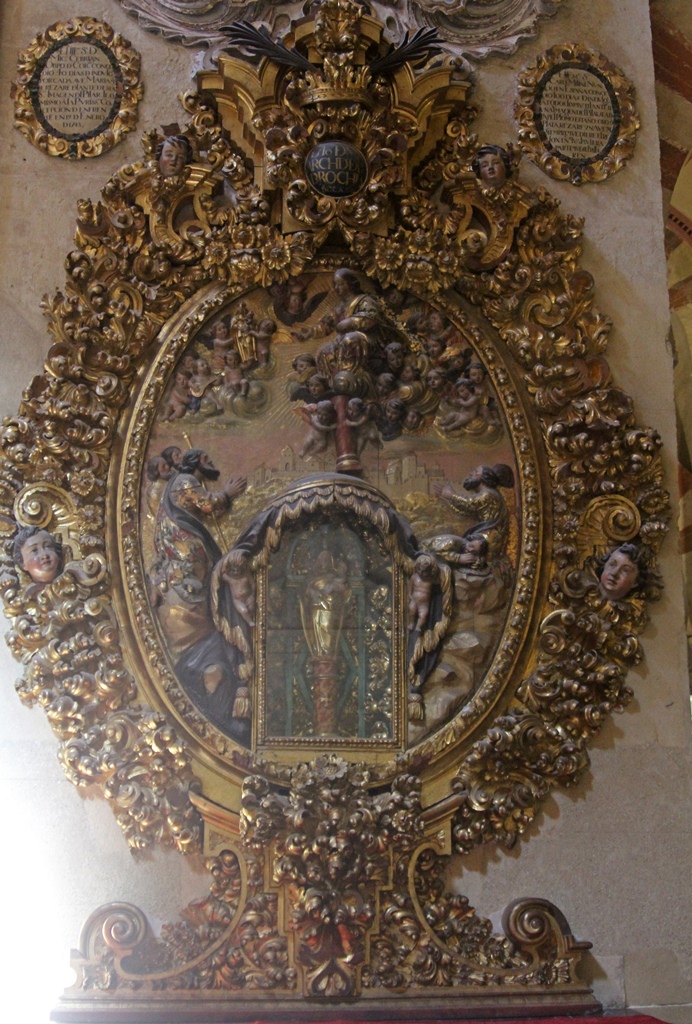
Altar of Our Lady of the Pillar
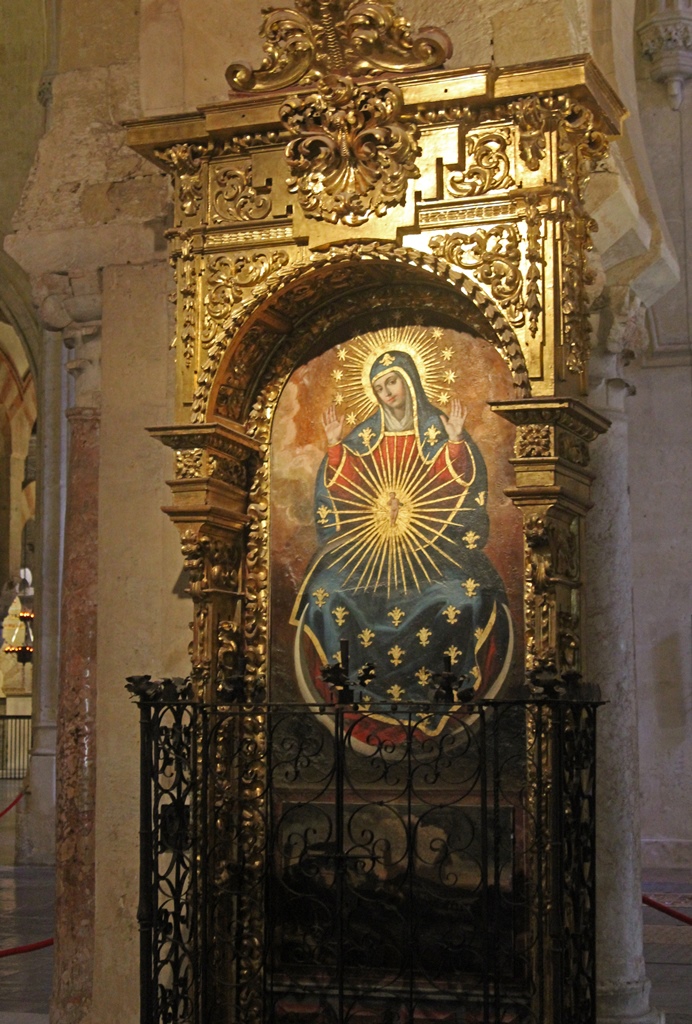
Altar of Our Lady of the Sun
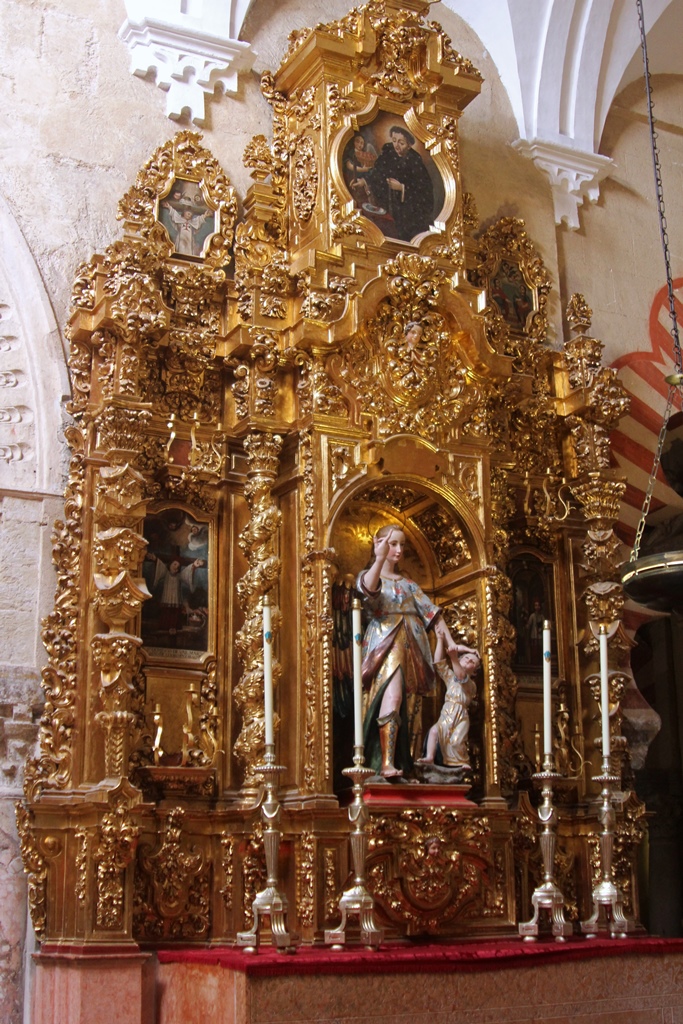
Altar of Santa María el Azul and Angel de la Guarda
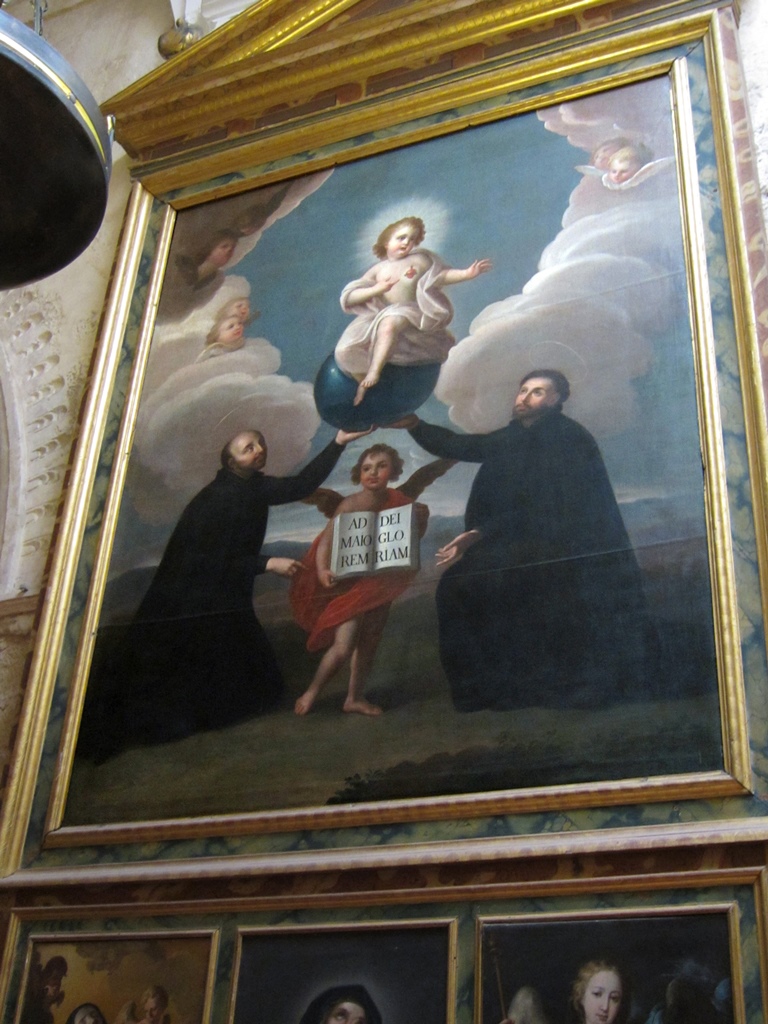
Altar of San Isidoro, San Leandro and San Ignacio
Another theme consistent with other cathedrals we'd visited was the fact that Catholics
love their chapels. The many chapels of the Mezquita are mainly lined up along the
east, west and north walls of the building. This explains why many of the doors found
on the outside of the building don't go anywhere – there are chapels in the way. As in
many cathedrals, most of the chapels are behind gates, probably to protect them from
tourists who might poke at them. Taking pictures of them between the bars is usually
possible, though.
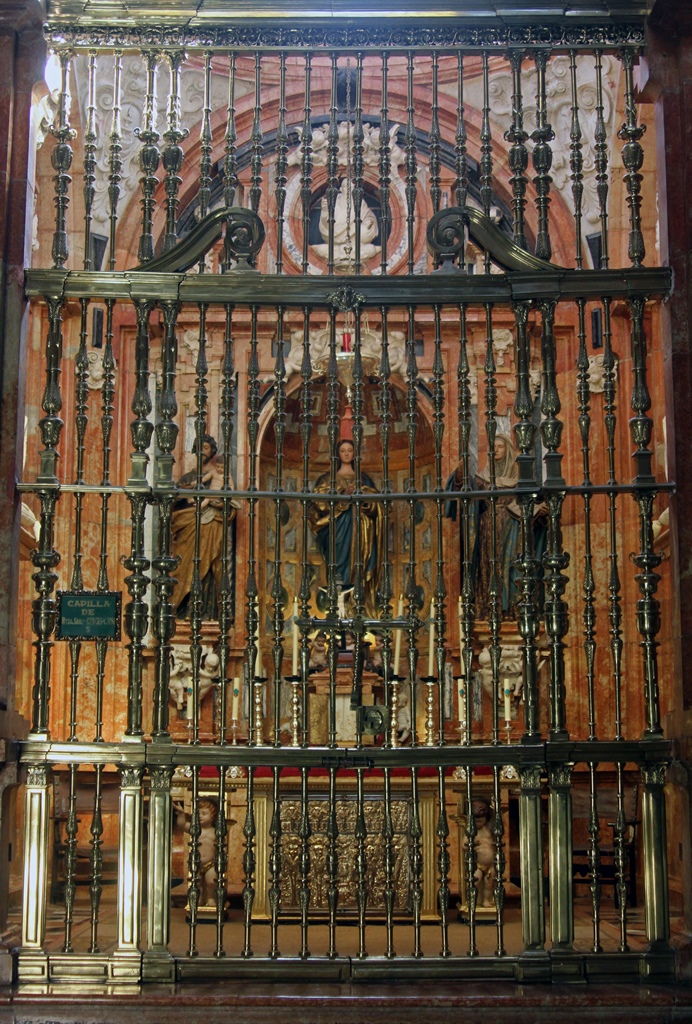
Chapel of Our Lady of the Conception
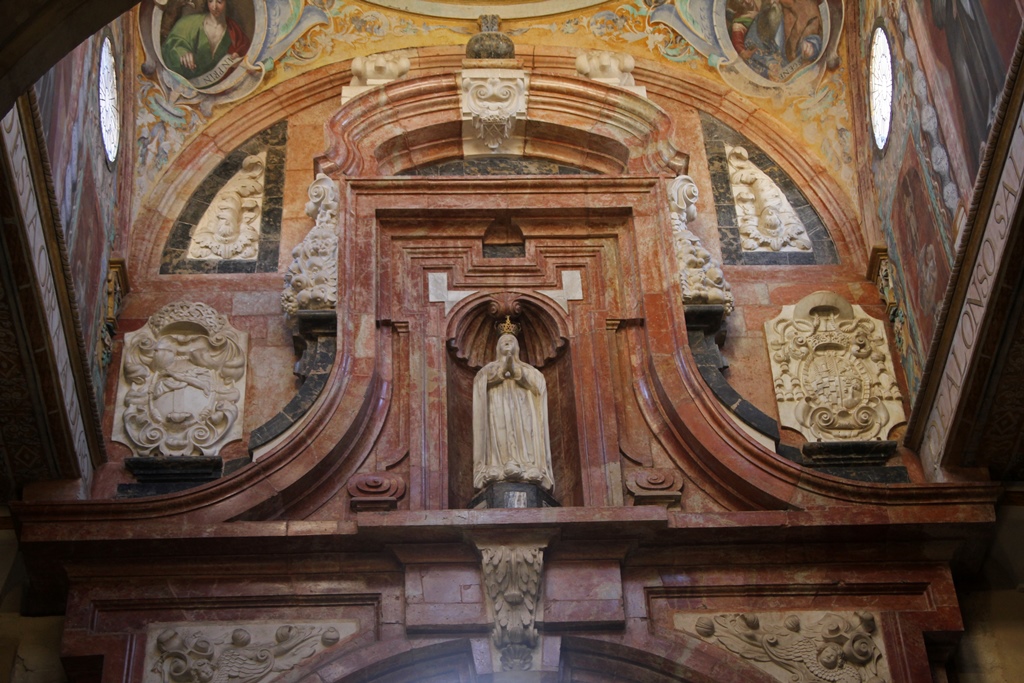
Chapel of Our Lady of the Conception, detail
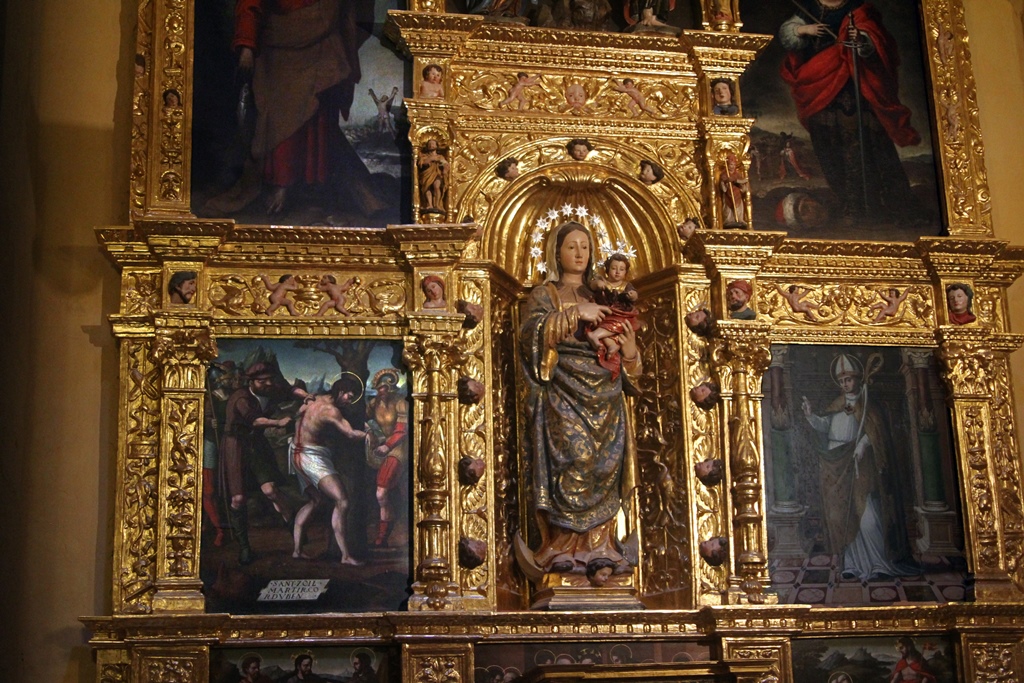
Old Chapel of Our Lady of Conception
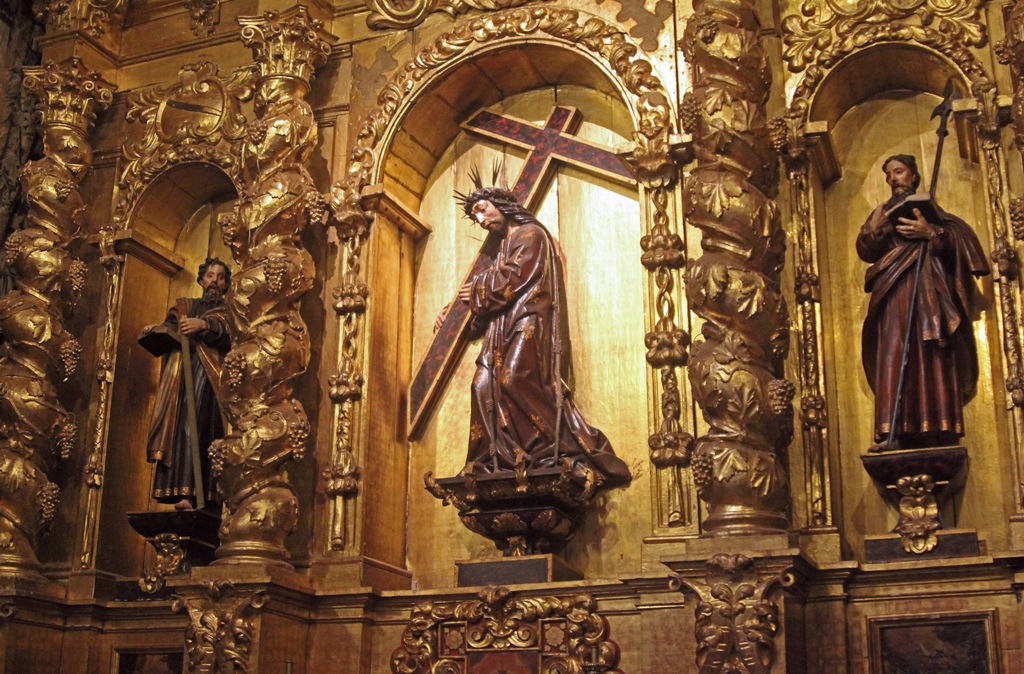
Chapel of San Simón and San Judas
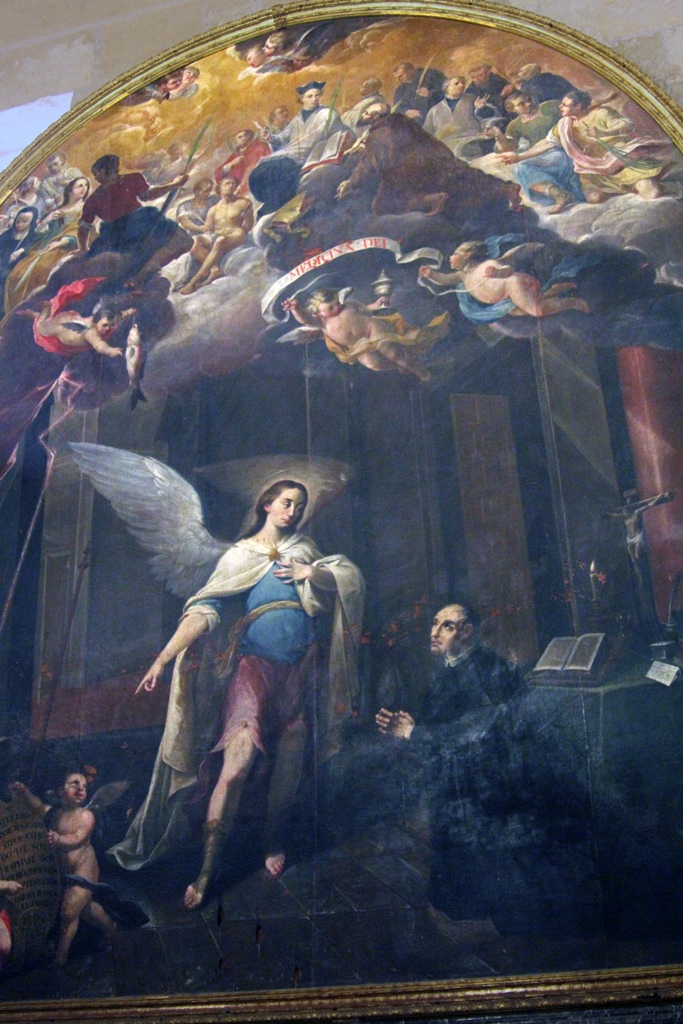
Chapel of San Agustín and Santa Eulalia de Mérida
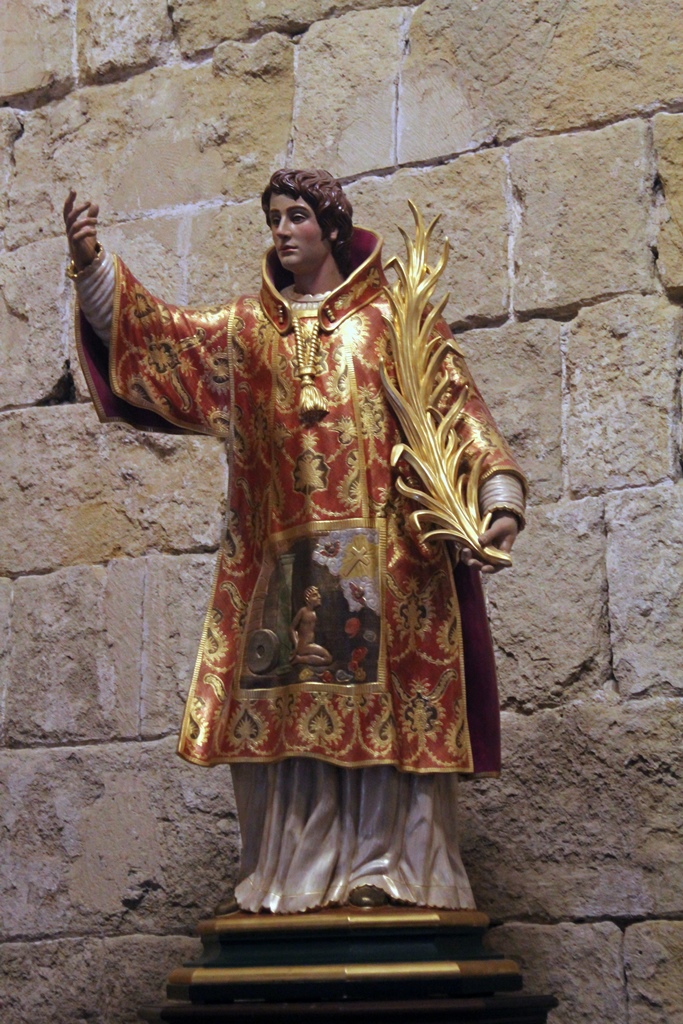
Chapel of Our Lady of the Snows and St. Vincent Martyr
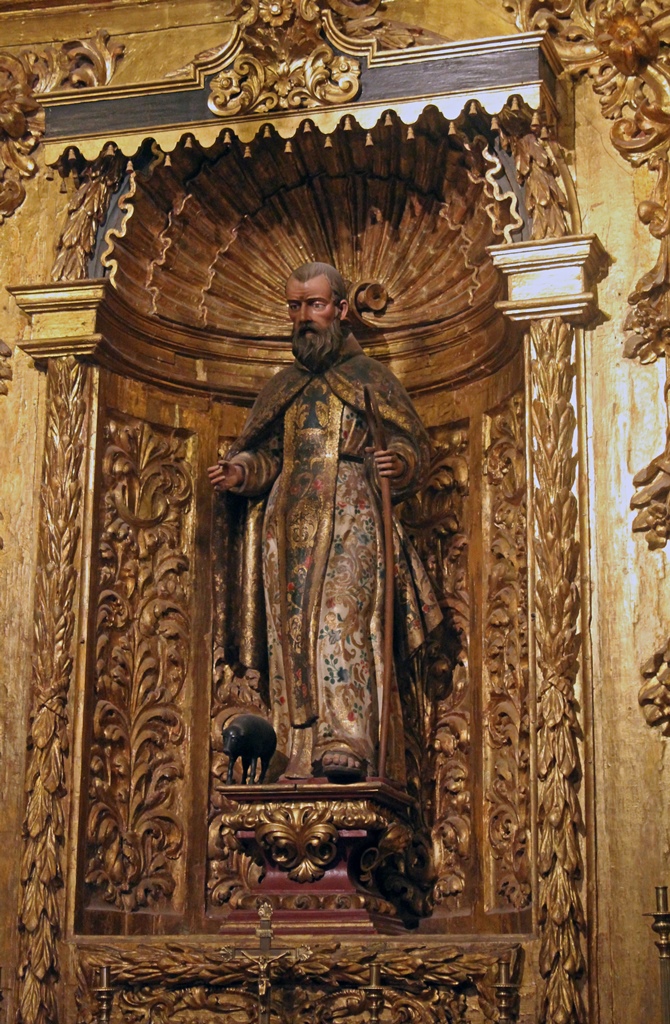
Chapel of San Antón
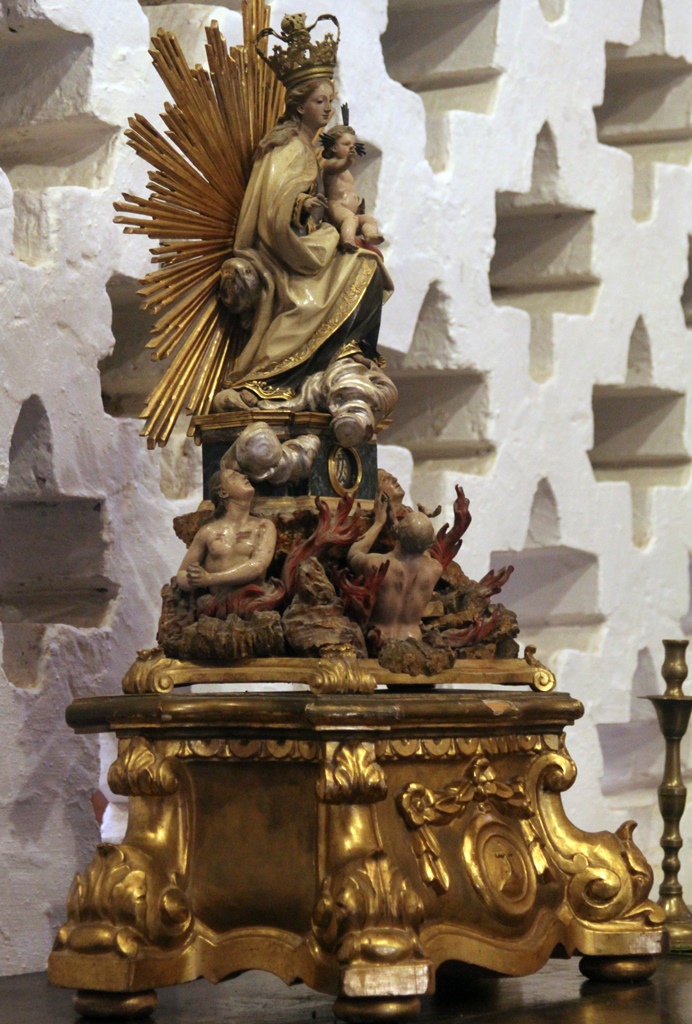
Chapel of the Holy Trinity
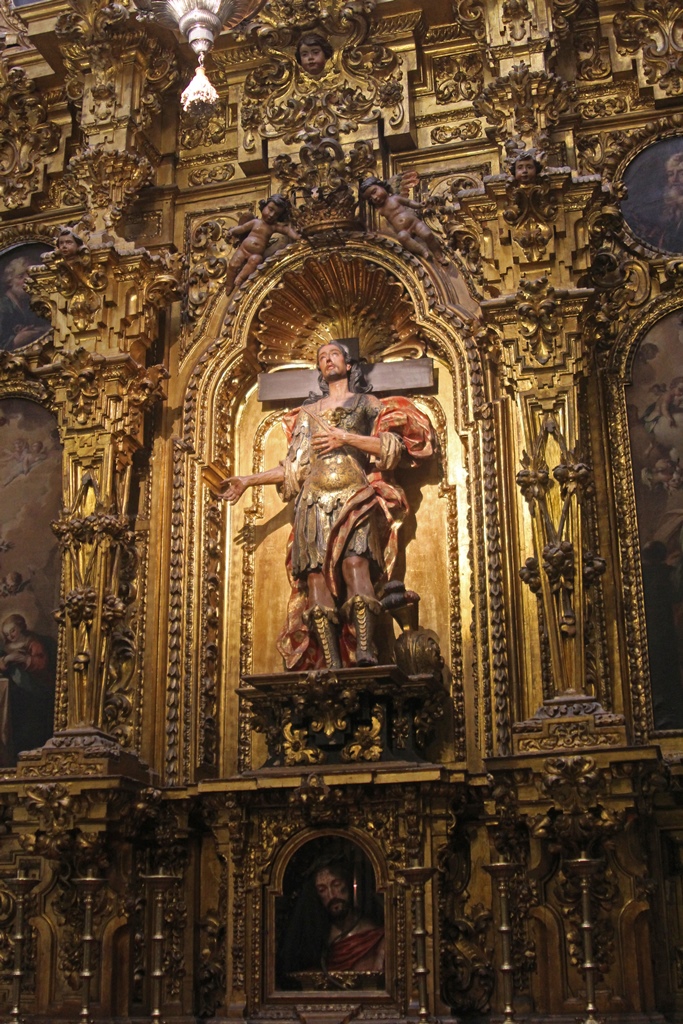
Chapel of San Acacio and Companions
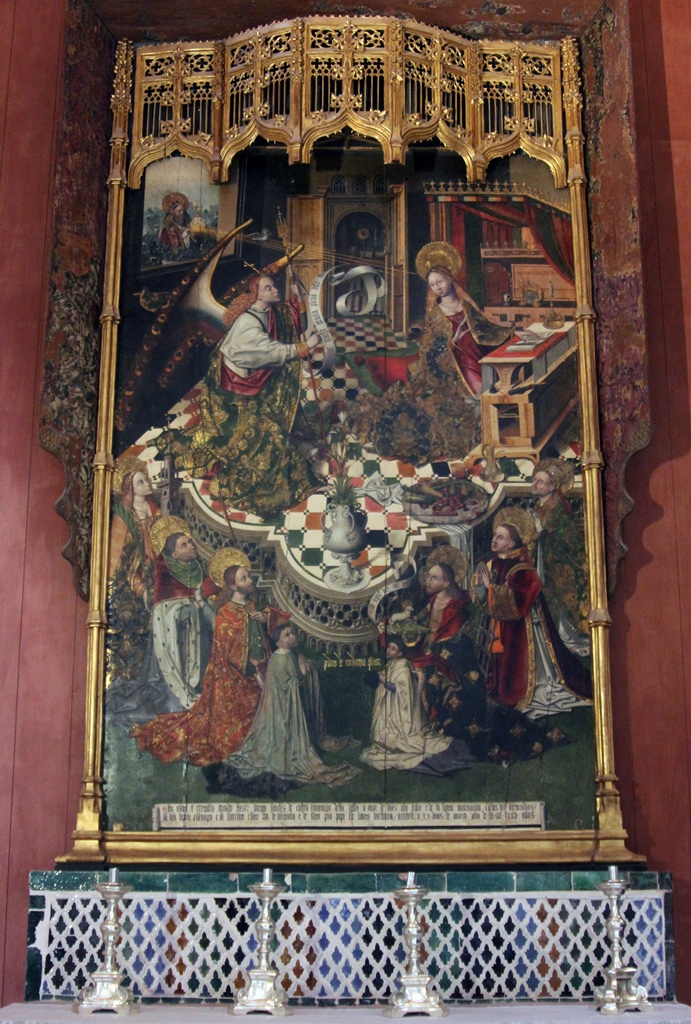
Altar of the Incarnation
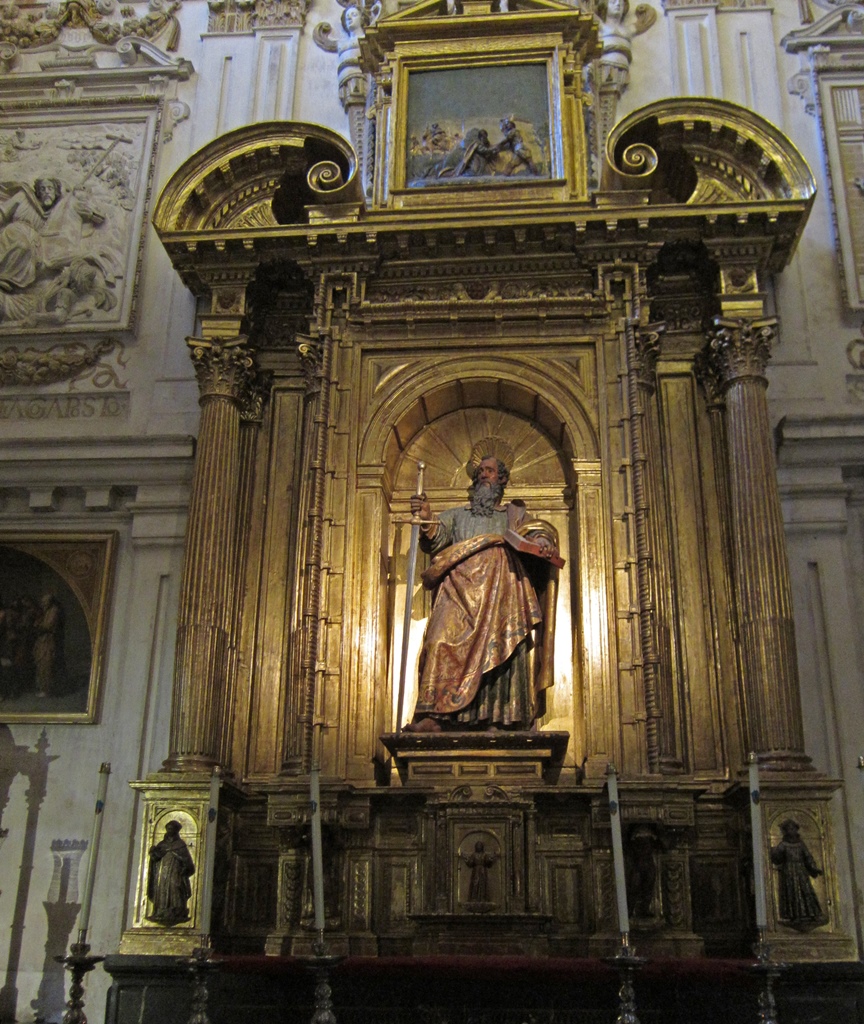
Chapel of the Conversion of St. Paul
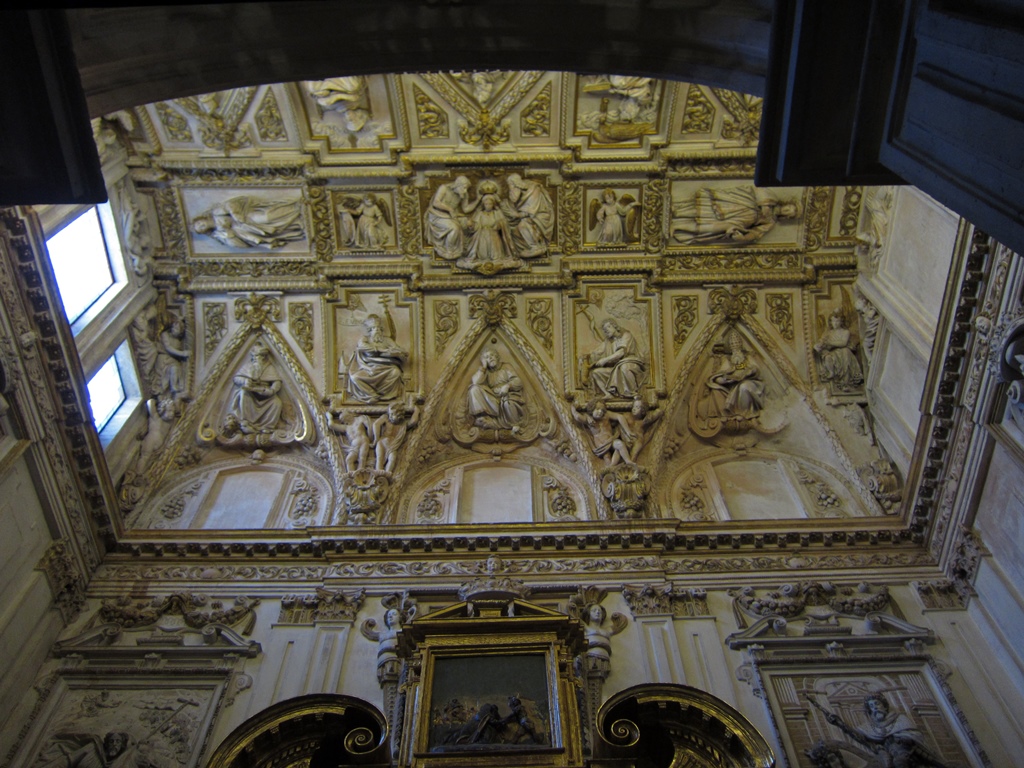
Ceiling, Chapel of the Conversion of St. Paul
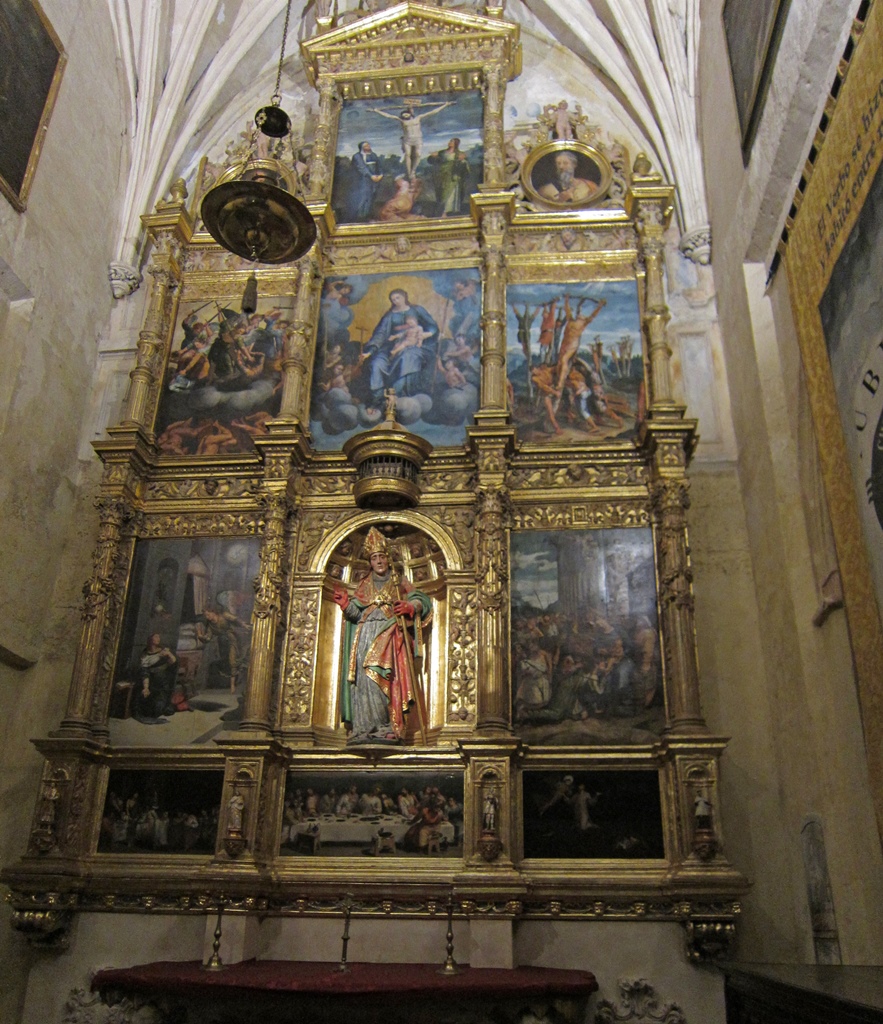
Chapel of Ihesu Verde and San Nicolás de Bari
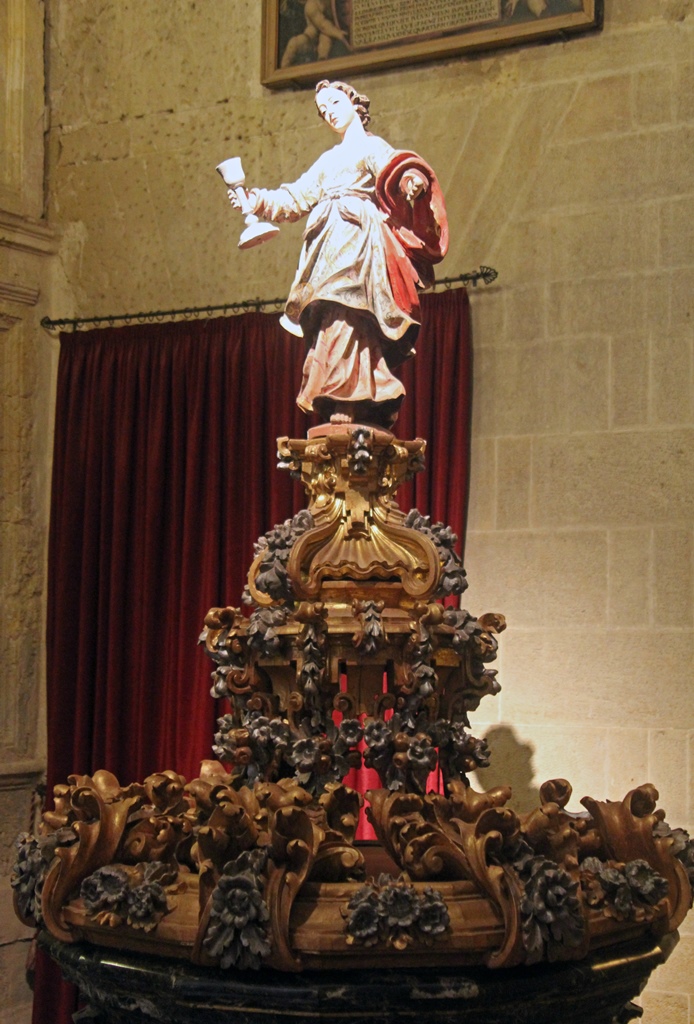
Chapel of Santa Marina, San Matías and the Baptistery
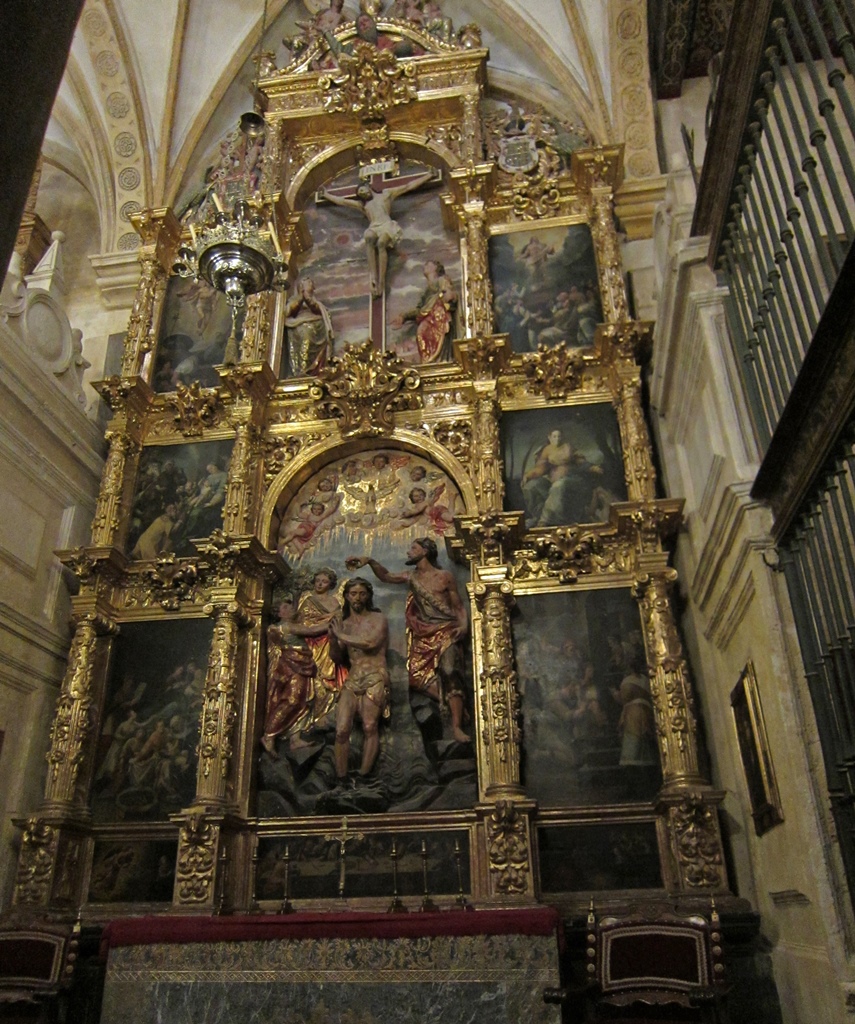
Chapel of San Juan Bautista
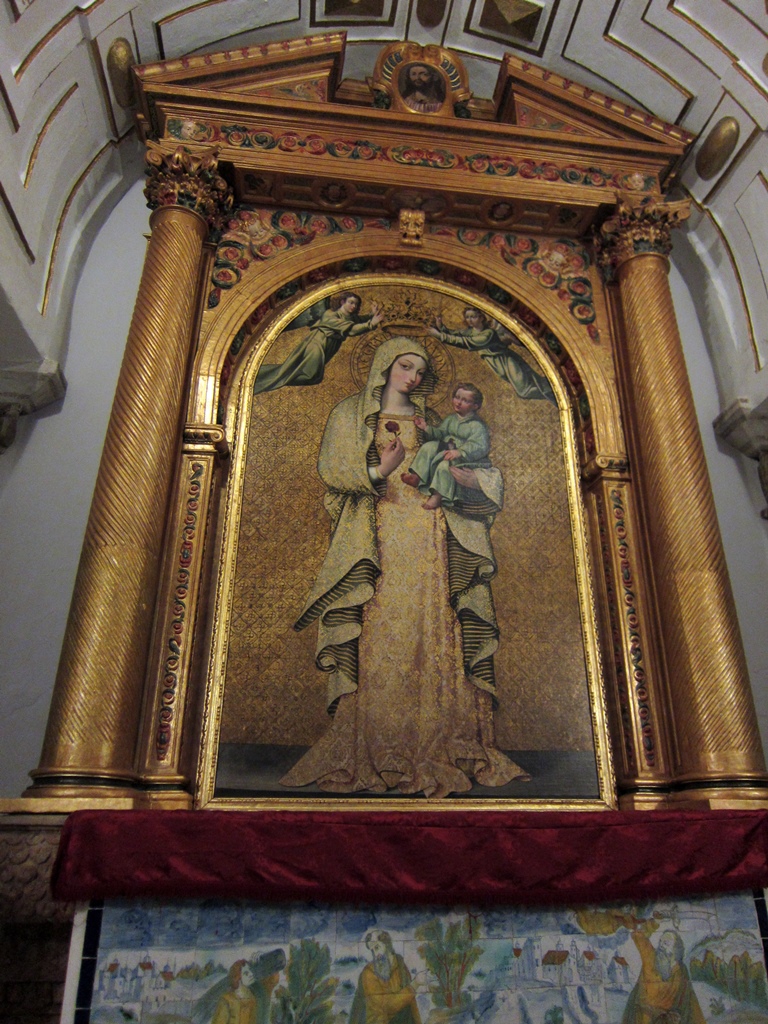
Capilla de Nuestra Señora de la Antigua
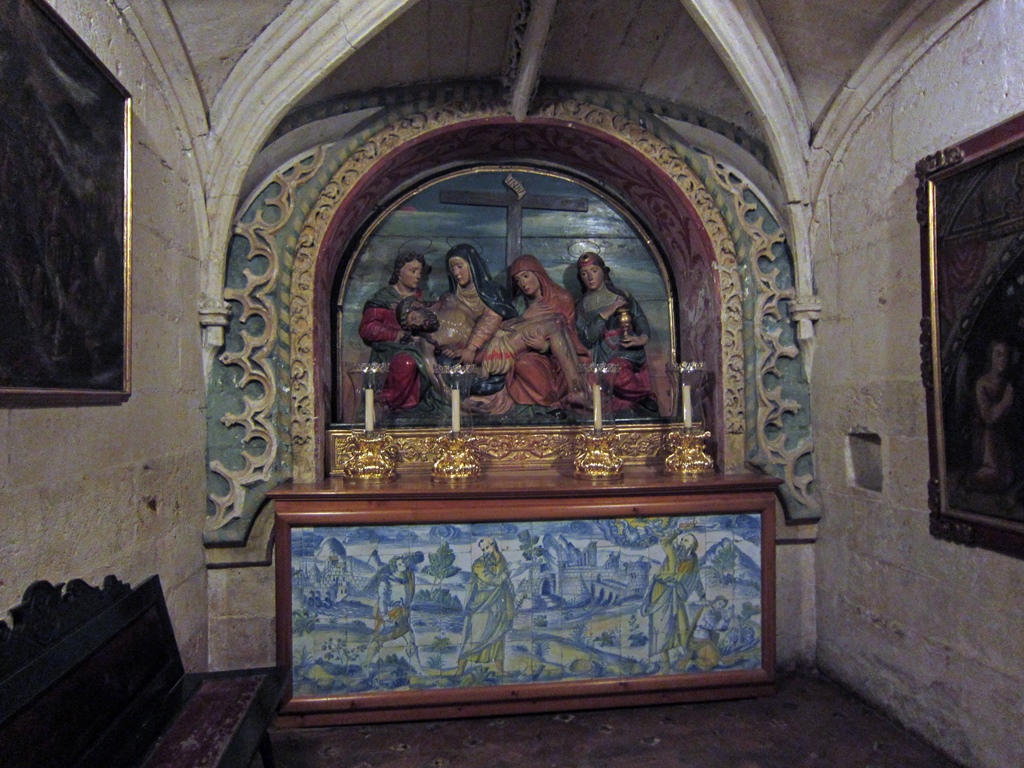
Chapel of the Angel of the Guard
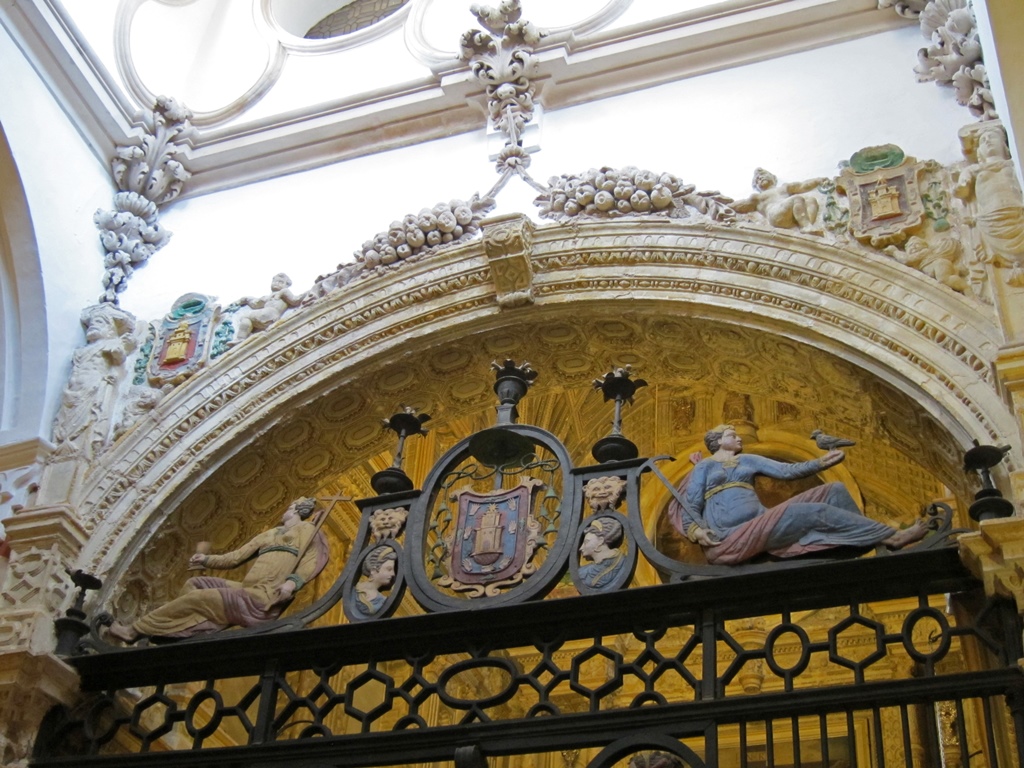
Grille, Chapel of the Holy Spirit
Some chapels are more elaborate than others. One such chapel is the Chapel of St. Teresa,
which is actually open to visitors (partly because it's part of the Treasury, discussed
below). This chapel is octagonal, and contains a number of altars and paintings. The
two most prominent works in the chapel are probably the tomb of Cardinal Salazar and the
Monstrance of Arfe. The large tomb is made from both black and white marble and holds the
mortal remains of Cardinal Don Pedro de Salazar, who was Bishop of Córdoba from 1686 until
his death in 1706. During his lifetime he sponsored a hospital and a convent in Córdoba,
and conceived the idea for the chapel in which he is buried, which is also known as the
Chapel of Cardinal Salazar. The Monstrance of Arfe is impossible to miss, as it sits in
the center of the room and is nearly nine feet tall. The Monstrance dates back to 1518,
and no, it wasn't dedicated to someone's dog – it was created by a goldsmith named Enrique
de Arfe.
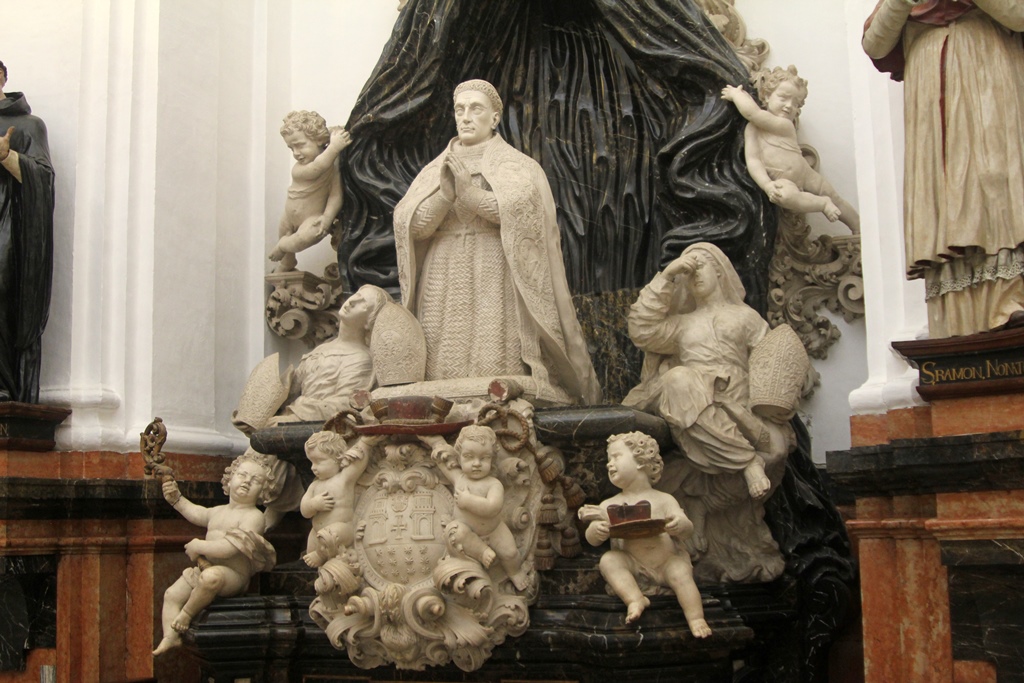
Chapel of St. Teresa - Salazar Tomb
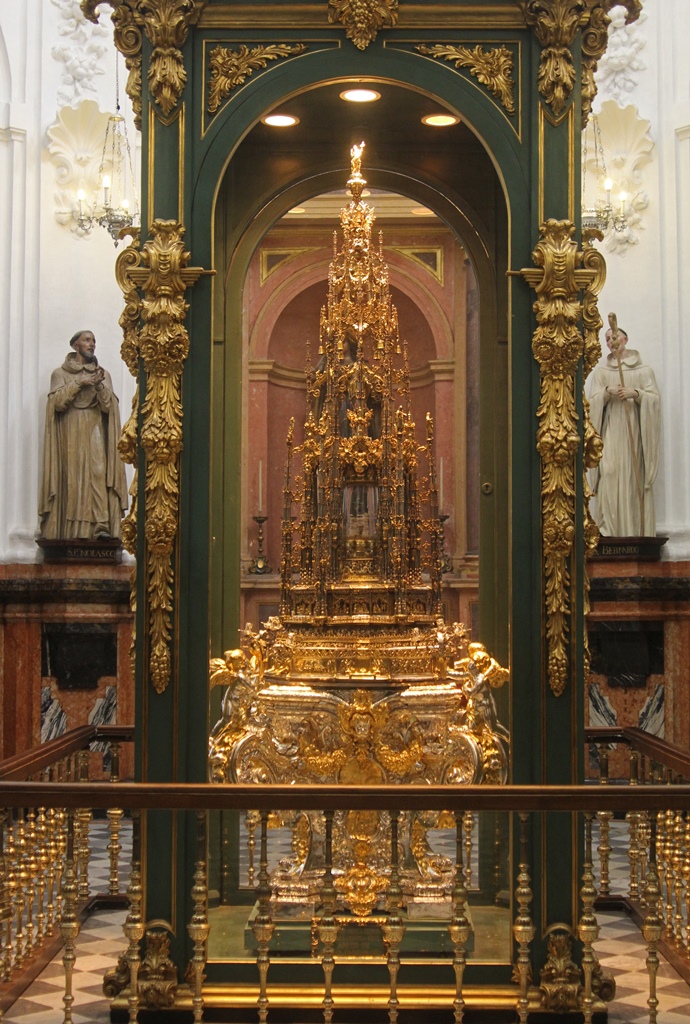
Monstrance of Arfe
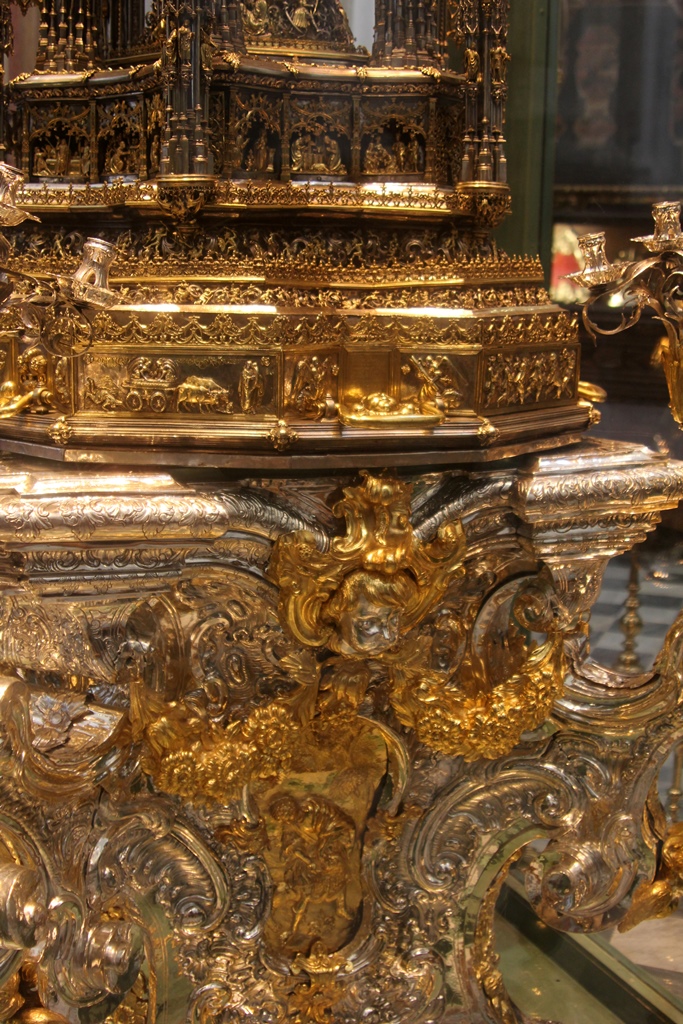
Monstrance of Arfe, detail
The largest chapel, located in the southeast corner of the Mezquita, is the 16th Century
Chapel of the Tabernacle, which could be a whole church by itself. It has three naves
and several rows of pews, and every square inch of the walls and ceiling appears to be
covered with artwork. We weren't able to get a very close look at any of it, though, as
the gate was locked and we had to peer through the bars. Apparently a number of bishops
are buried in this chapel.
Chapel of the Tabernacle
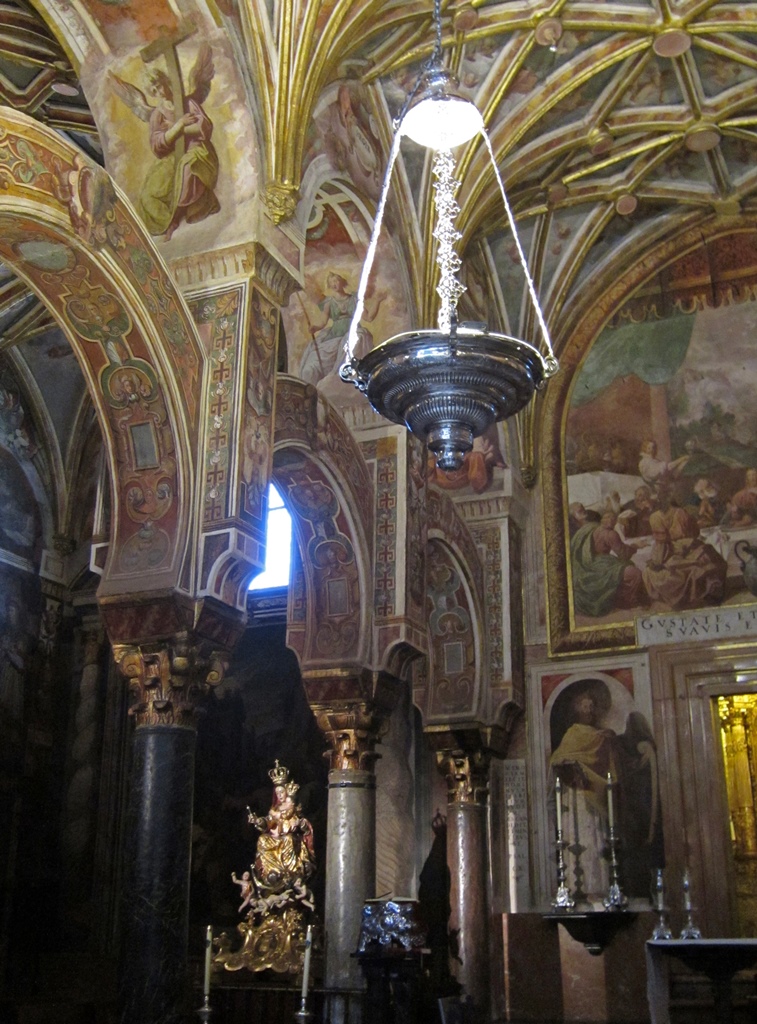
Chapel of the Tabernacle
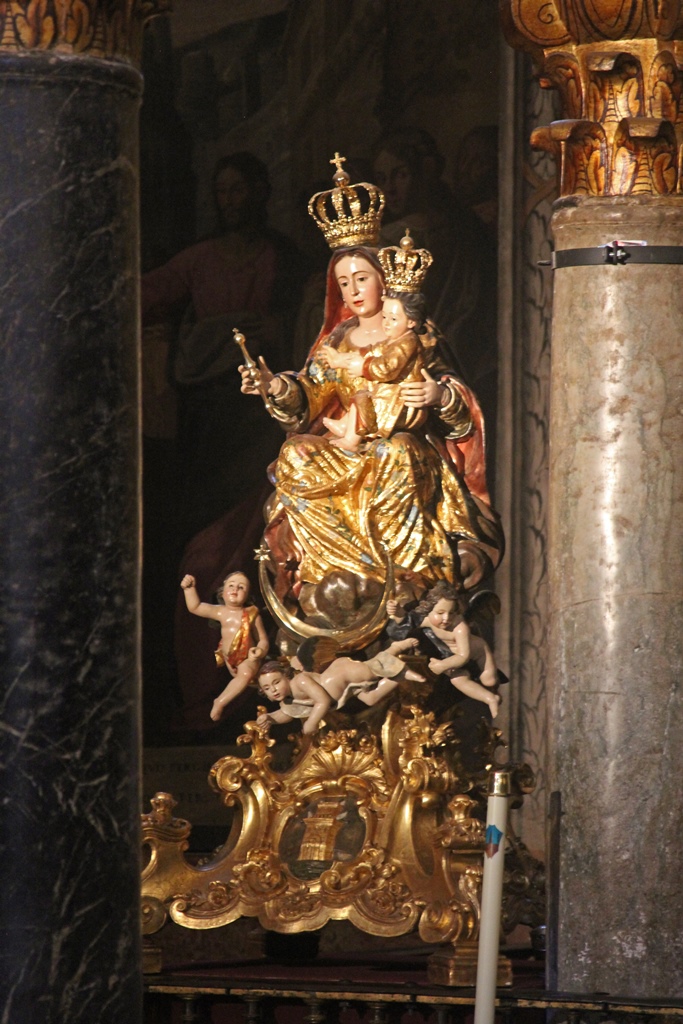
Madonna & Child, Chapel of the Tabernacle
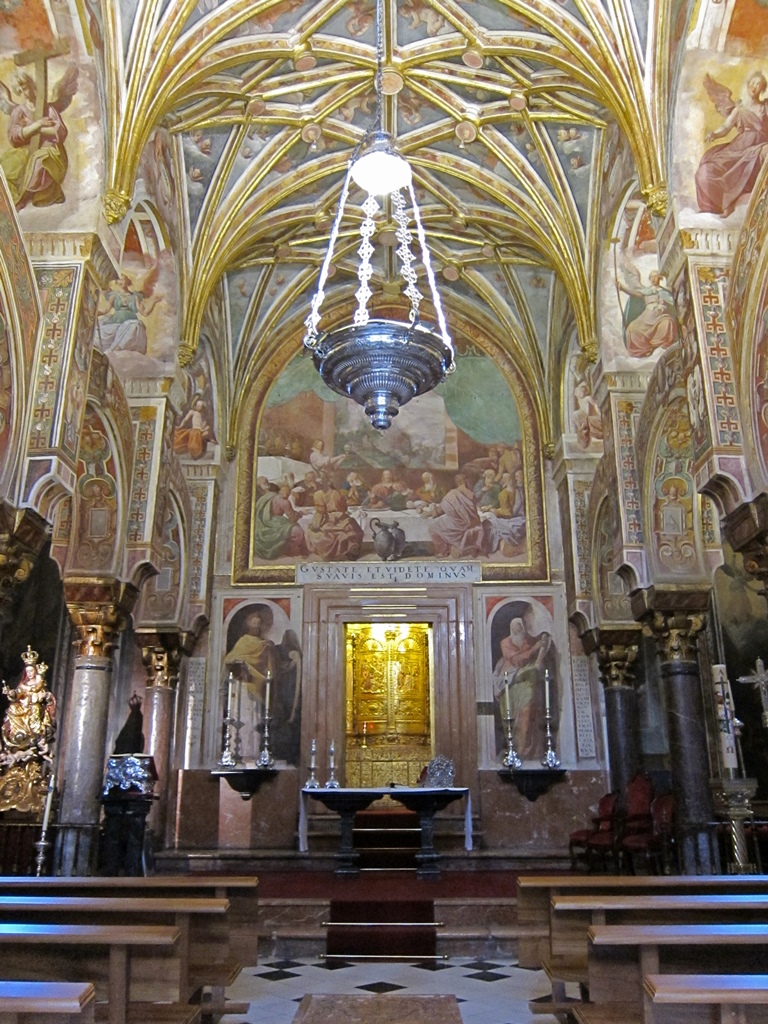
Chapel of the Tabernacle
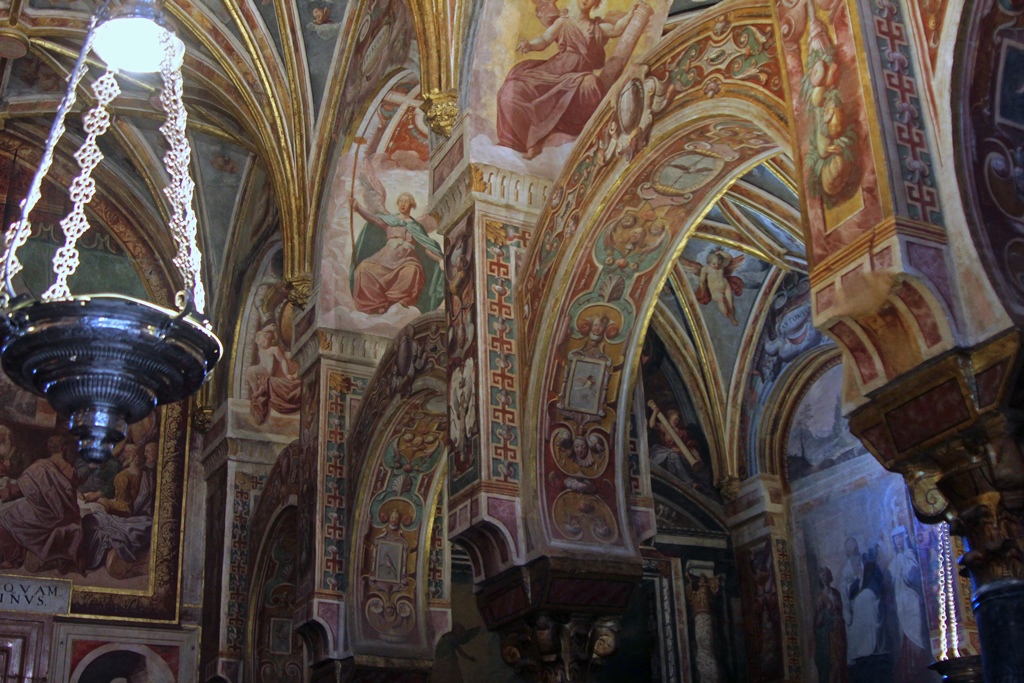
Chapel of the Tabernacle
Another chapel of special significance is the Royal Chapel, which is named for the fact
that it once contained the remains of two kings, Alfonso XI (1311-1350) and Ferdinand IV
(1285-1312). The chapel was built during the reign of Henry II (1334-79), the son of
Alfonso XI (and grandson of Ferdinand IV). For those keeping track, this is the Henry
of Trastámara who gained the throne by stabbing his half-brother Pedro the Cruel to
death (as described in
the page for Seville's Alcázar).
Alfonso and Ferdinand were eventually moved to the Church of San Hipólito, elsewhere in
the city, so the chapel isn't as royal as it used to be. It's not possible to enter this
chapel, but there are openings through which some of it can be seen. The chapel is
decorated in semi-Moorish Mudejar style, and is presided over by a figure of Córdoba
conqueror Ferdinand III.
Royal Chapel
Centuries after the conquest of Córdoba, around 1516, the new bishop of Córdoba, Don
Alonso Manrique de Lara, embarked on a major initiative for the Mezquita. Up until
that point, Christian worship in the building had been centered in a Main Chapel which
was located near its western edge. De Lara felt that the main chapel should be in the
heart of the building, more toward its center. This developed into a major
disagreement between the clerics (many of whom actually disagreed with their bishop)
and the city council, who felt the Main Chapel should be left where it was. Things
became heated, with threats of violence from one faction and of excommunication from
the other going back and forth, until emperor Charles V intervened, telling everyone
to shut up and to let the bishop perform the construction he deemed necessary. The
construction began in 1523 and lasted until 1607, and the result has been called a
"cathedral within a mosque". This "cathedral" (not really an accurate name, as the
whole Mezquita is a cathedral) is visible from the outside as an apparent church
protruding from the top of the otherwise mostly flat building, and on the inside as
a tall, brightly-lit Renaissance church, with no architectural relationship to the
Moorish arch-forest surrounding it. It's said that the emperor revisited in 1526,
after construction was well underway, and expressed regret that he'd green-lighted a
project that "destroyed something unique in the world", and replaced it with
something commonplace (many are skeptical that this really happened, as admitting to
a mistake would have been very out of character for Charles V). But regardless of
one's approval or disapproval of the project, one would have to admit that a cathedral
sprouting from the middle of a mosque is actually pretty unique.
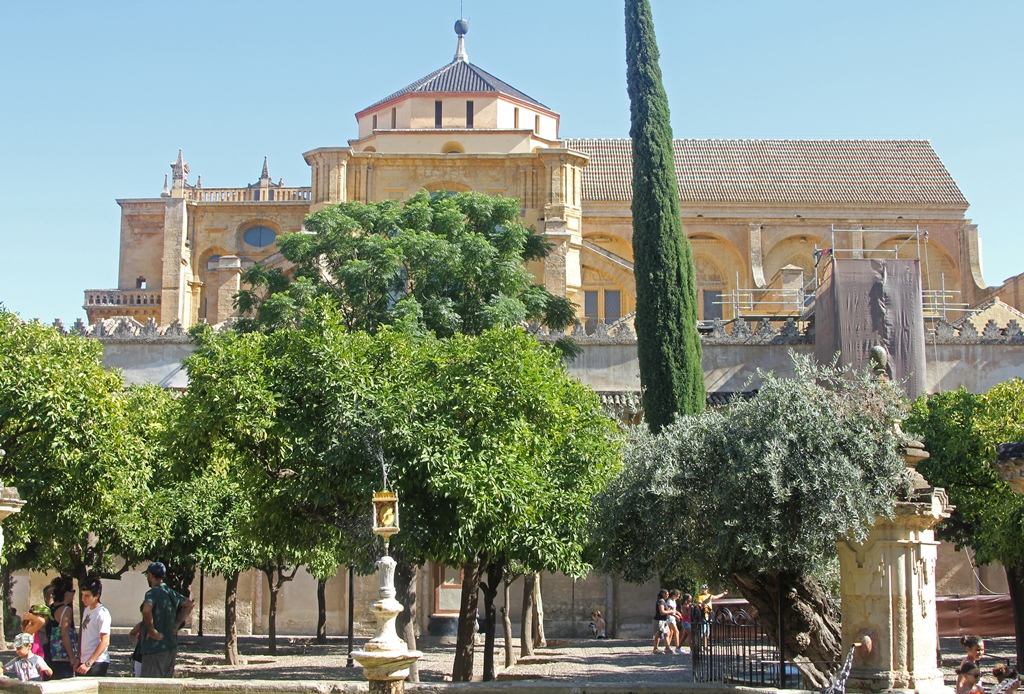
Mezquita with "Cathedral"

Entering the Great Chapel
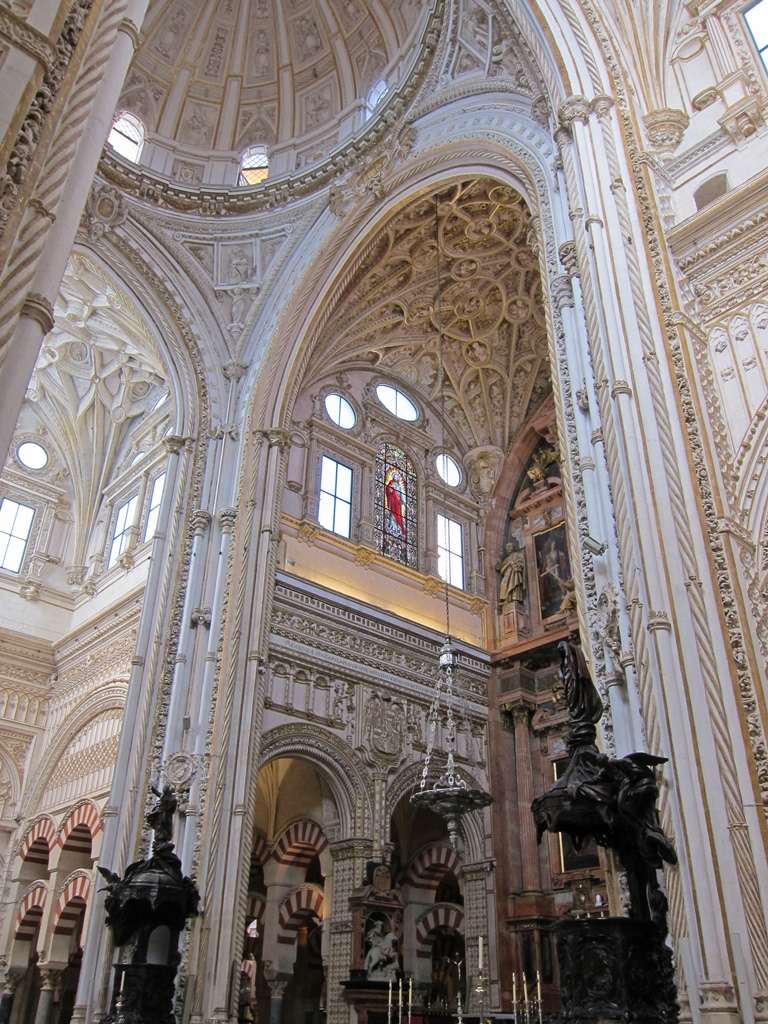
Great Chapel
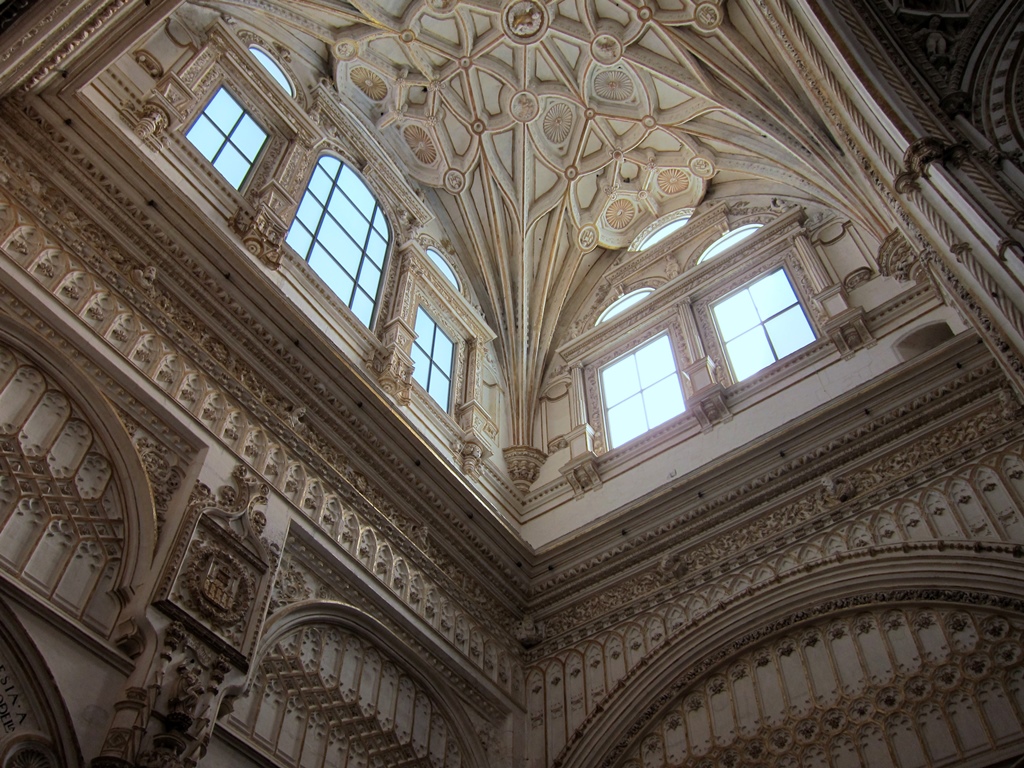
Ceiling and Windows

Pulpit and Great Chapel
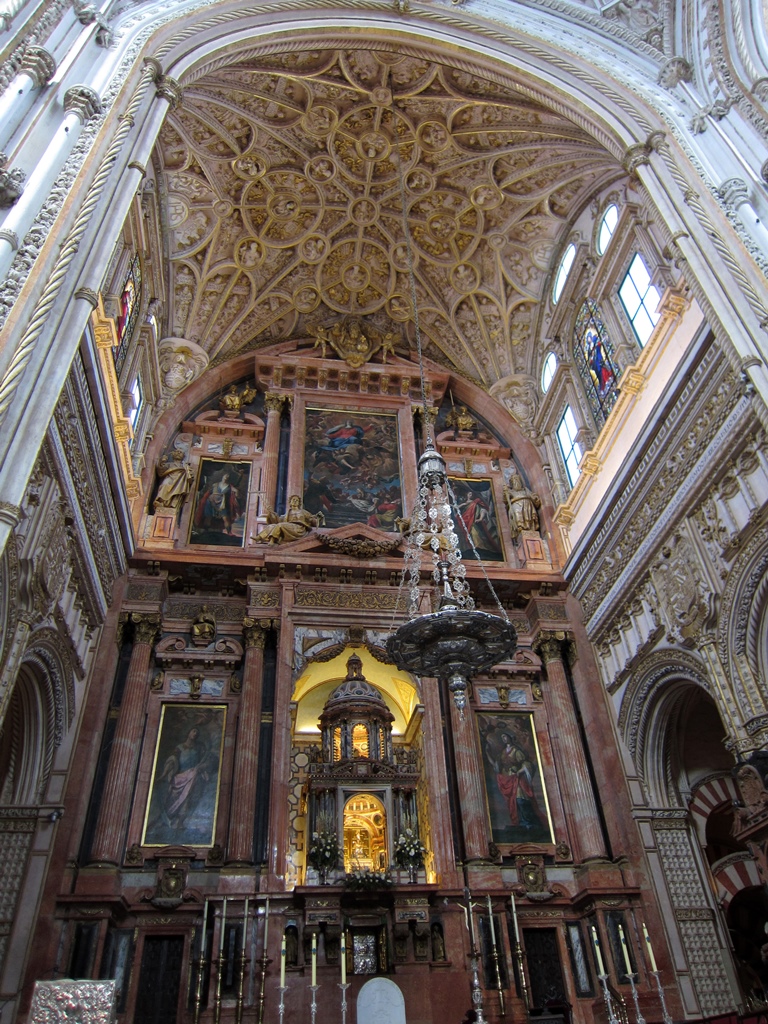
Great Chapel
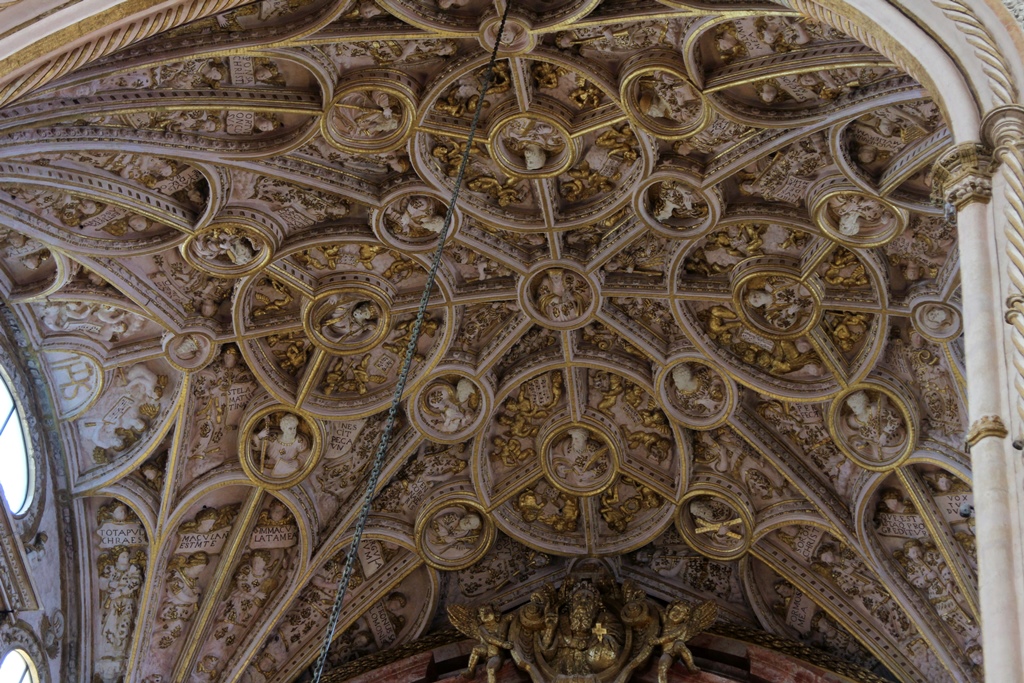
Ceiling
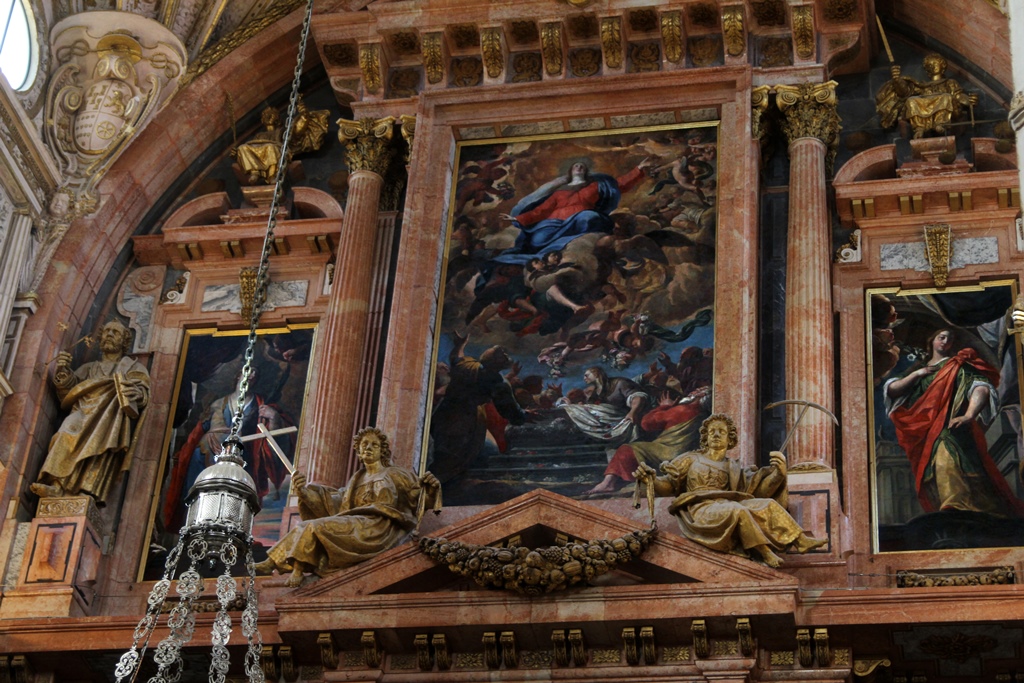
Top of Altarpiece
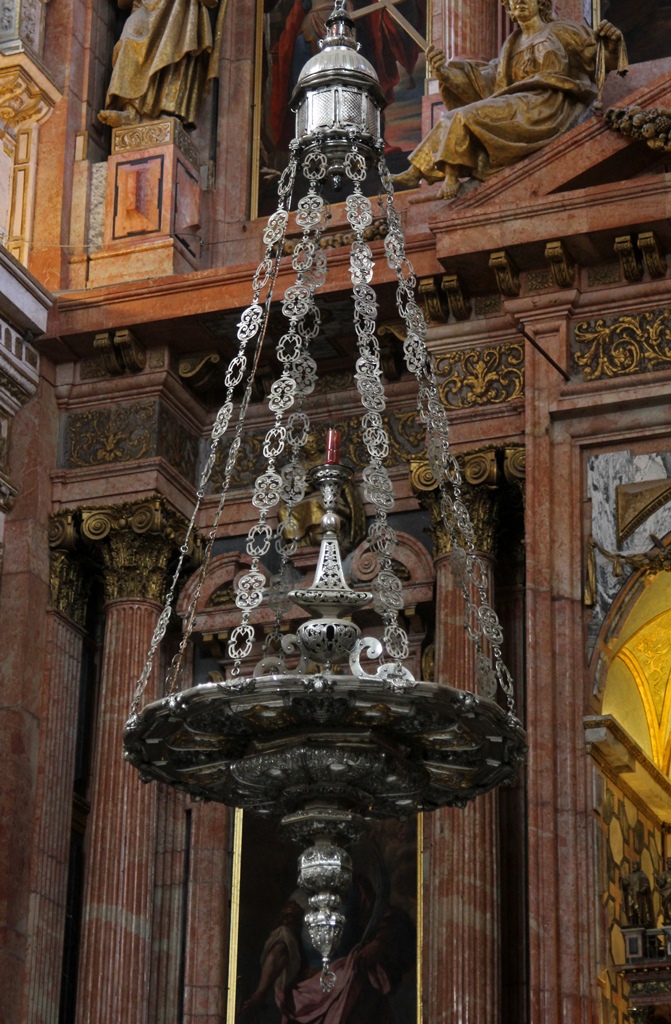
Lamp
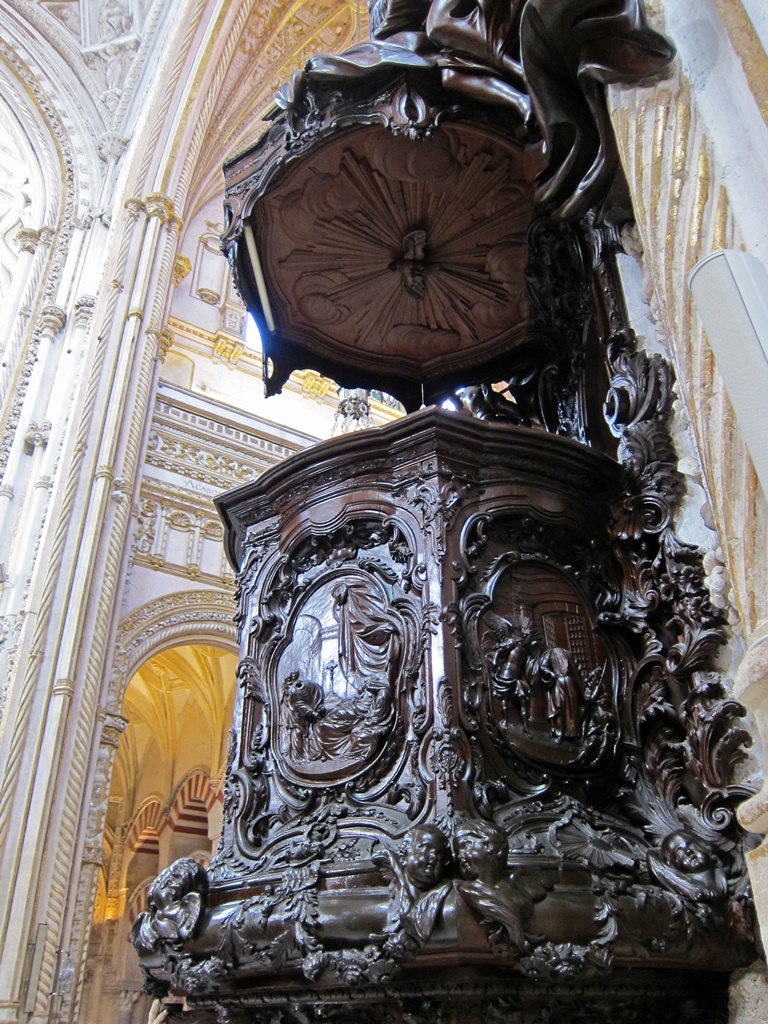
Pulpit
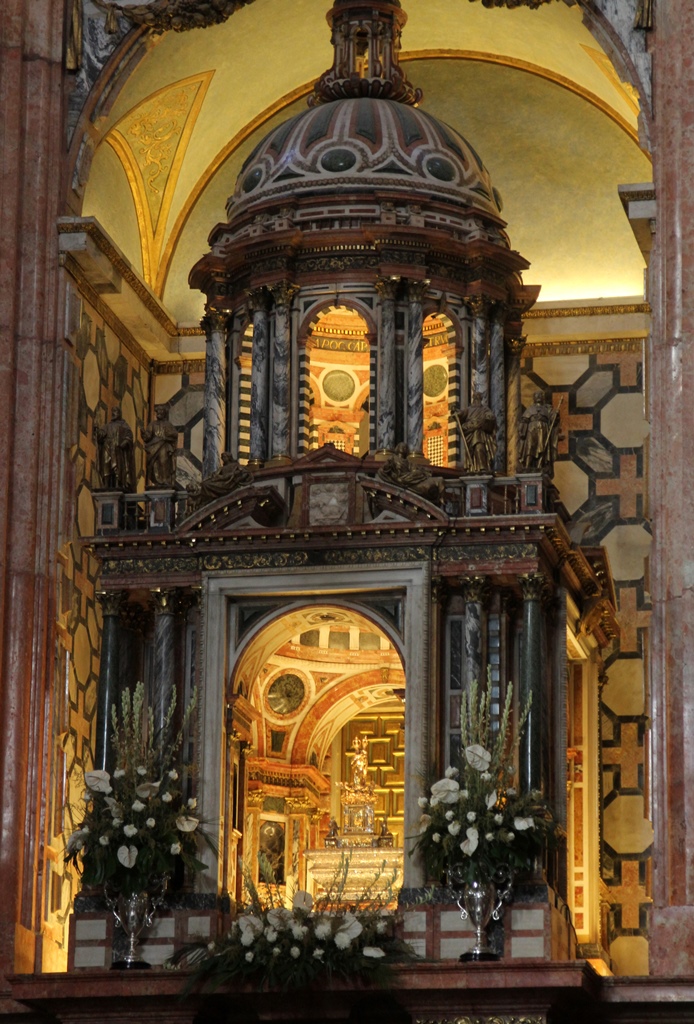
Altarpiece "Temple"
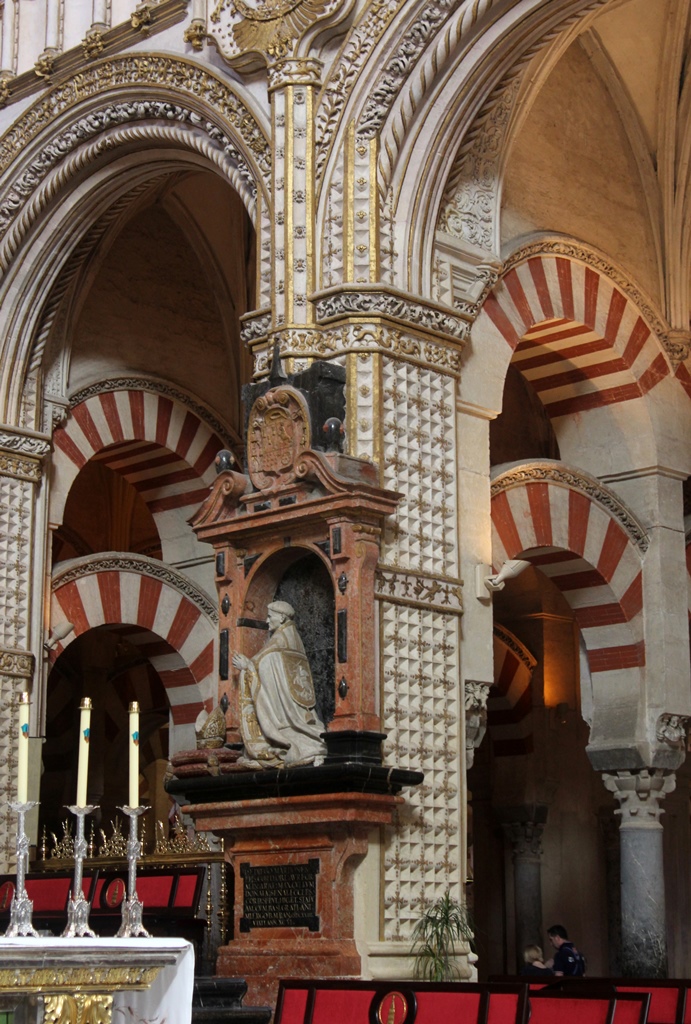
Tomb of Bishop Mardones
De Lara didn't get a chance to micromanage the construction of his chapel, as he was
named Archbishop of Seville in 1523, when construction was beginning. This forced
him to relocate - maybe his superiors felt he had worn out his welcome in Córdoba.
But those working on the chapel seem to have done a spectacular job, even without
his help. The entire structure is quite tall and flooded with light (especially
when compared to the dimness of the rest of the Mezquita), with the chapel itself
housing a gigantic marble altarpiece. But the chapel isn't just a chapel. The
structure also has a transept and a nave (with a dome at their intersection),
giving it a Latin cross layout. Beneath the nave is a choir filled with beautifully
carved wooden choir stalls and flanked by two huge dueling pipe organs. But that
seems to be about it – in particular, there is nowhere to put a large congregation
of worshippers, as you would normally have in a cathedral. This makes it difficult
to know exactly what to call this 16th Century insertion into the Mezquita. Maybe
a chapel on steroids.

Ceiling and South Organ
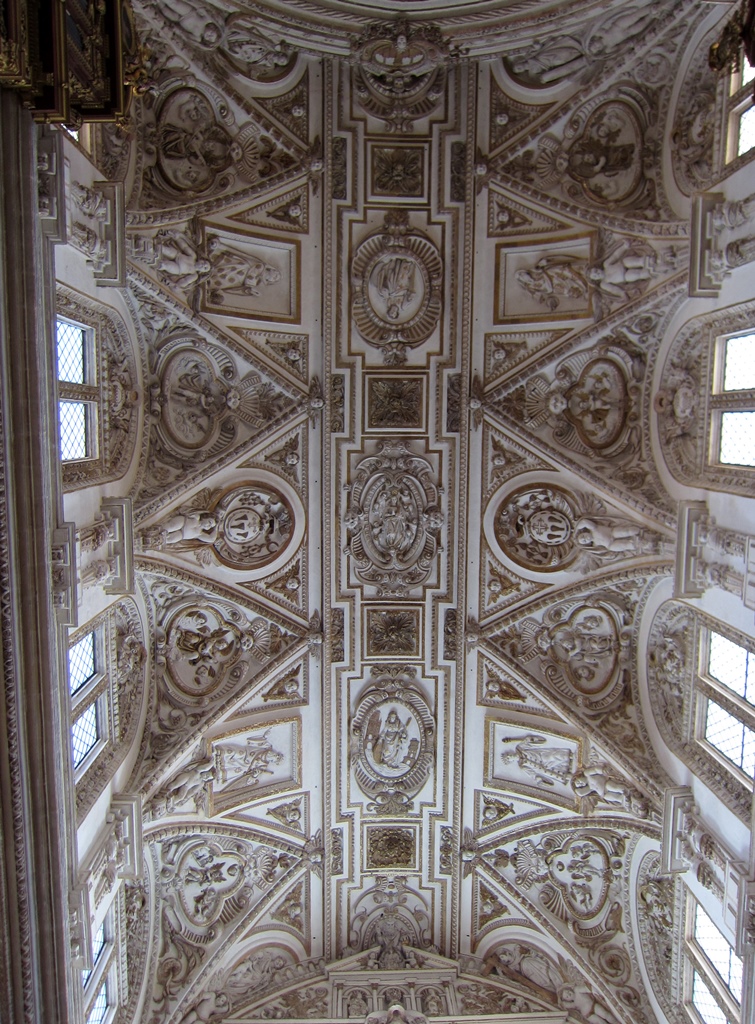
Ceiling
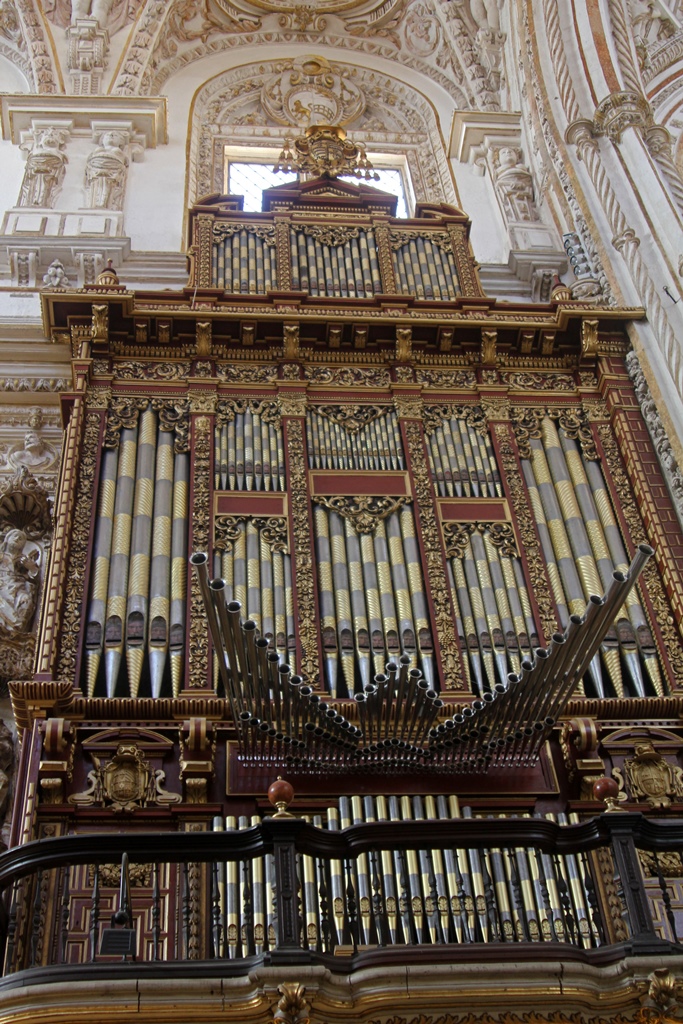
North Organ
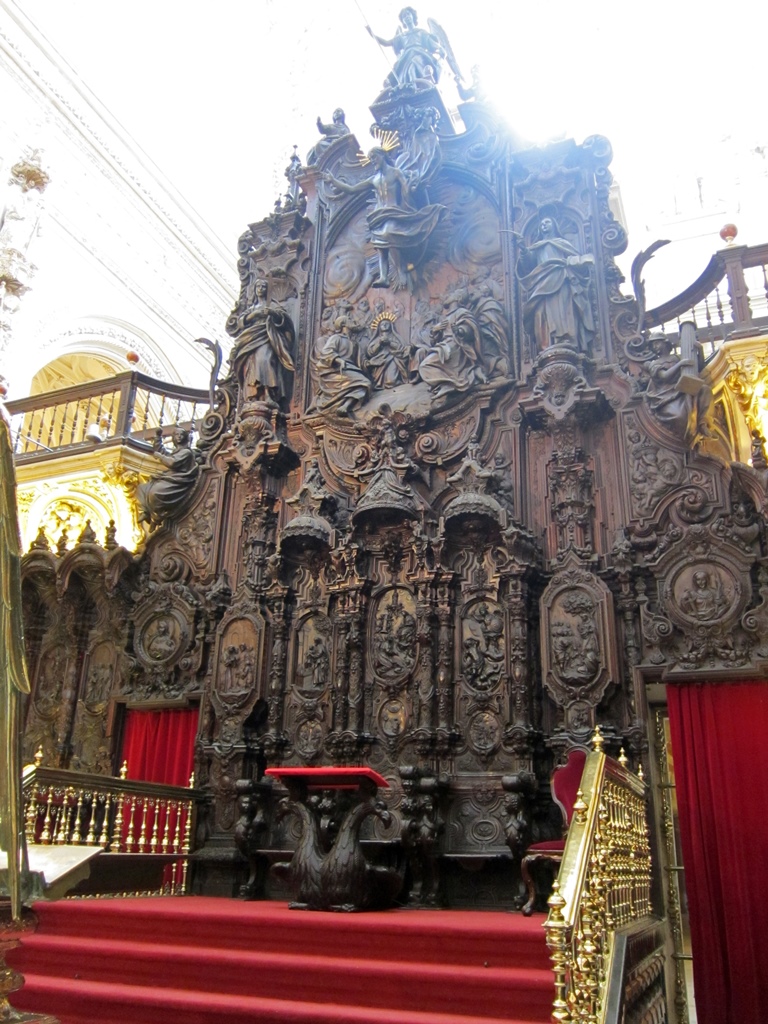
Episcopal Throne, Choir
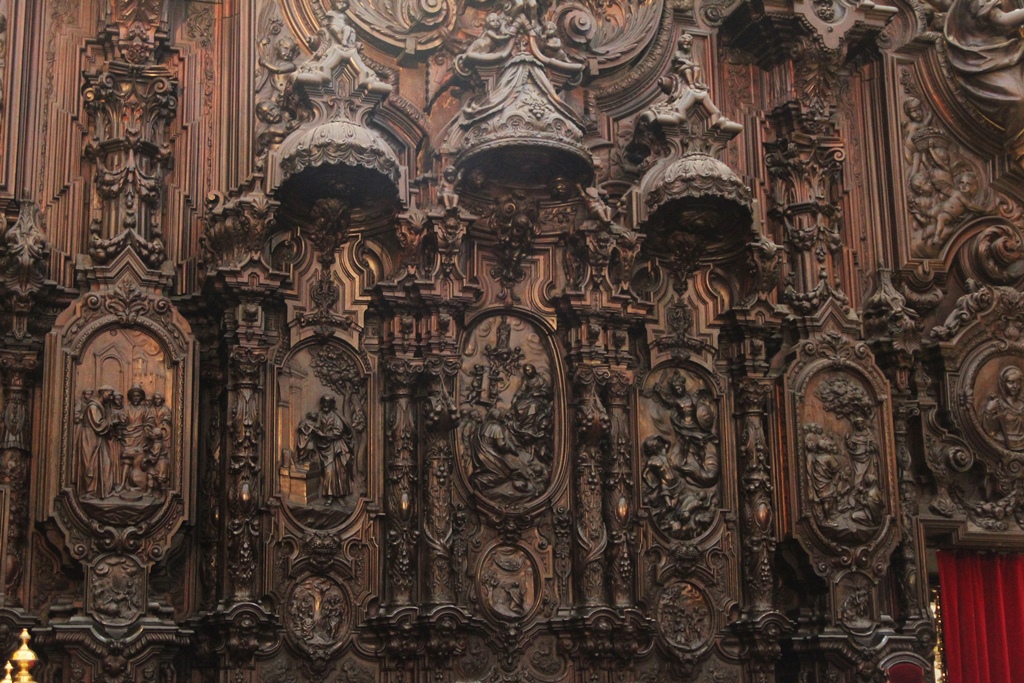
Episcopal Throne, Detail
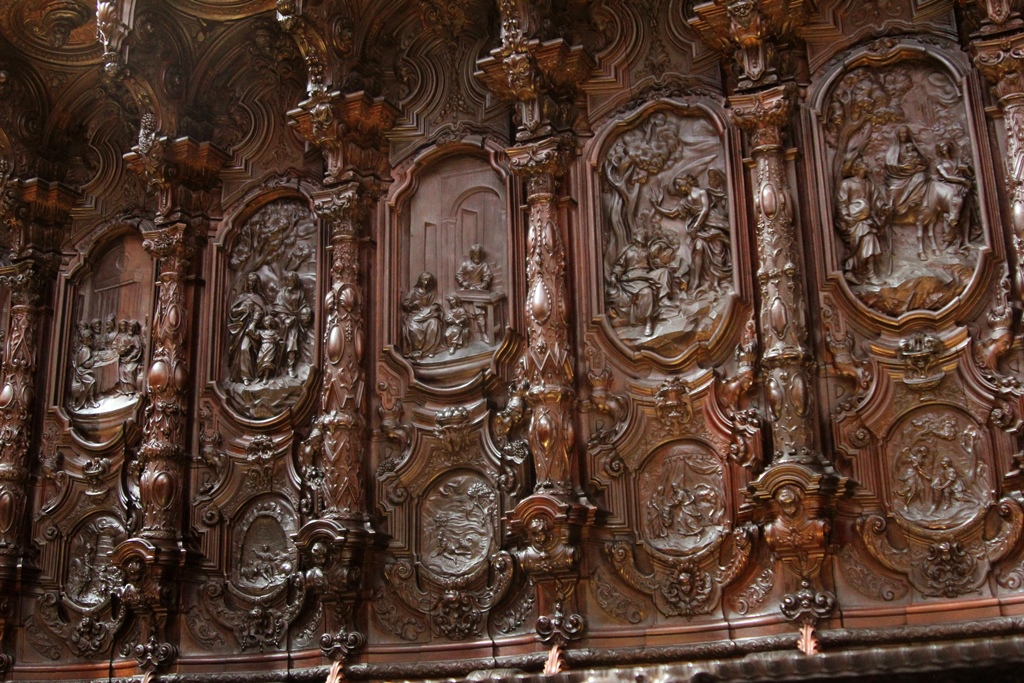
Choir Stalls, Detail
Cathedral Trascoro and Ceiling
The Mezquita is filled with valuable historical objects, mostly found in the chapels.
But some additional ones are found in the aforementioned Treasury, which includes the
Chapel of St. Teresa. Here are a few:
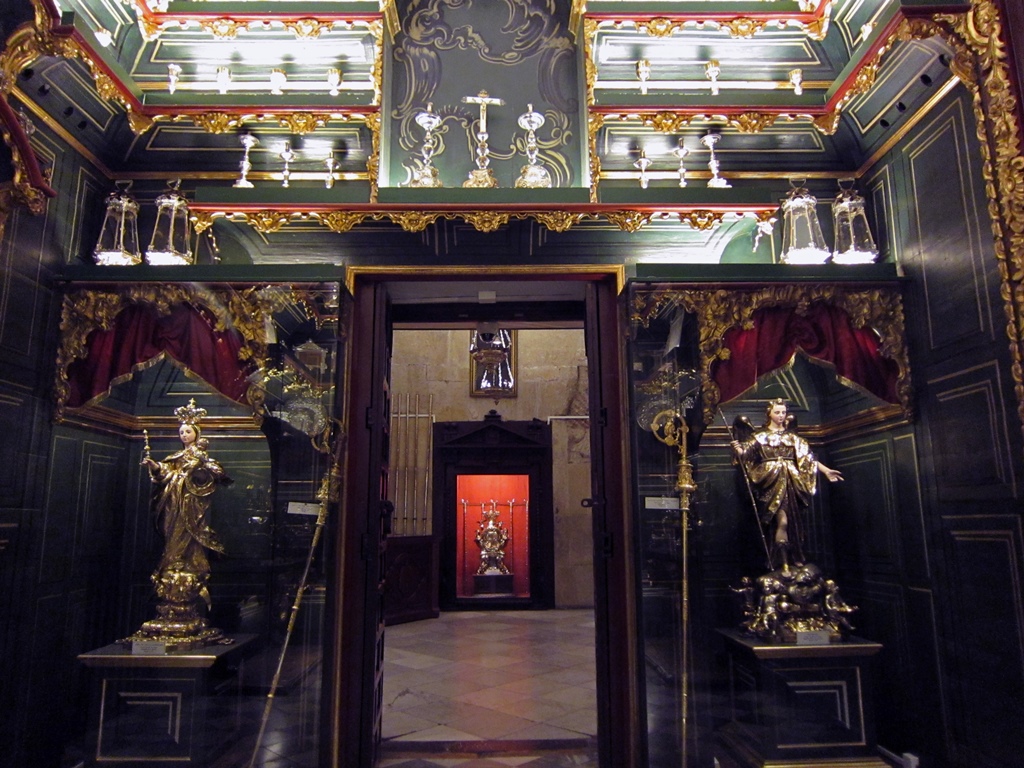
Treasure Room
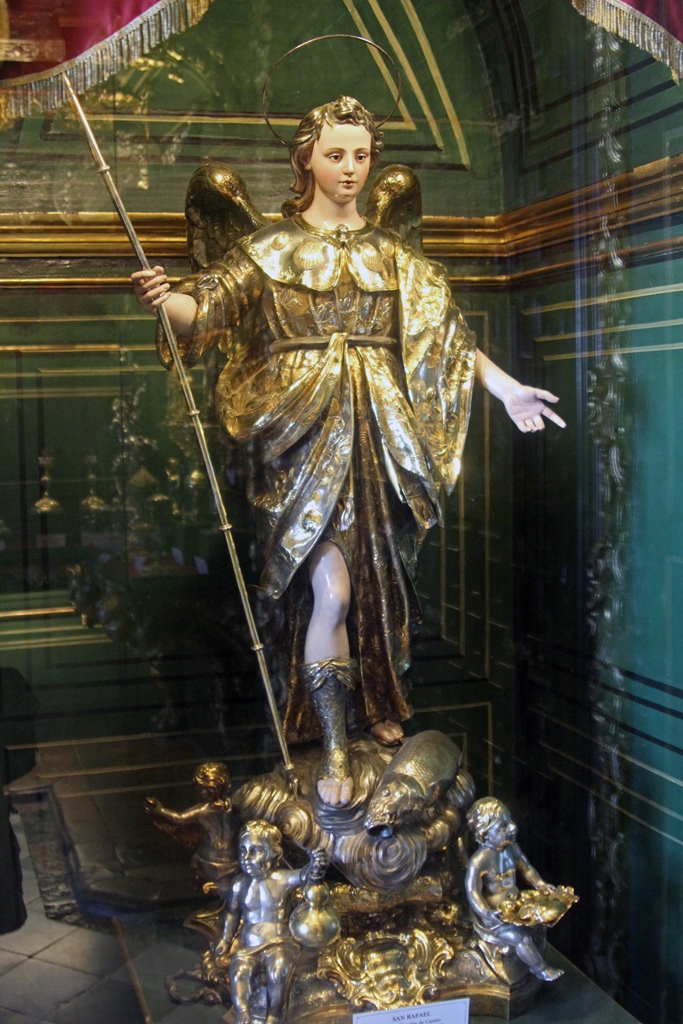
Treasure Room - Figure of San Rafael
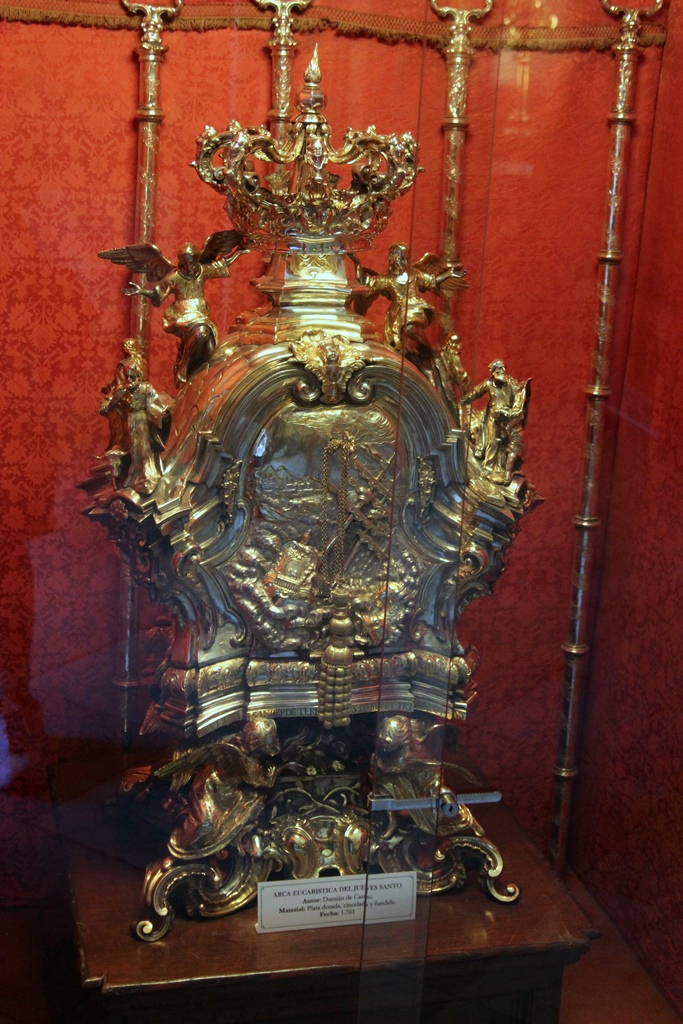
Ark of Holy Thursday
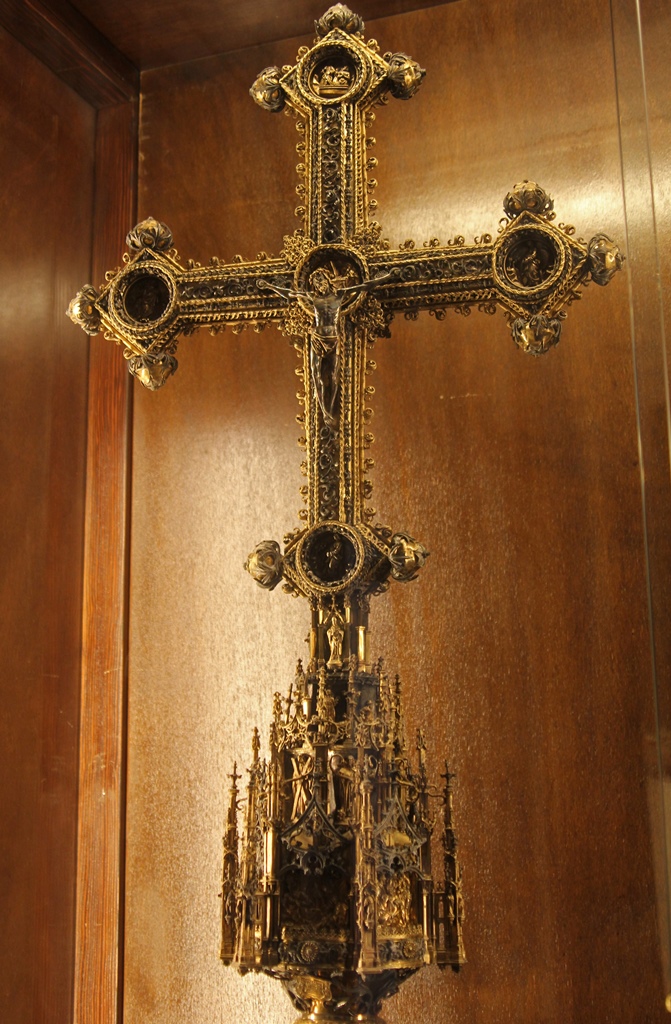
Processional Cross of Archdeacon Simancas
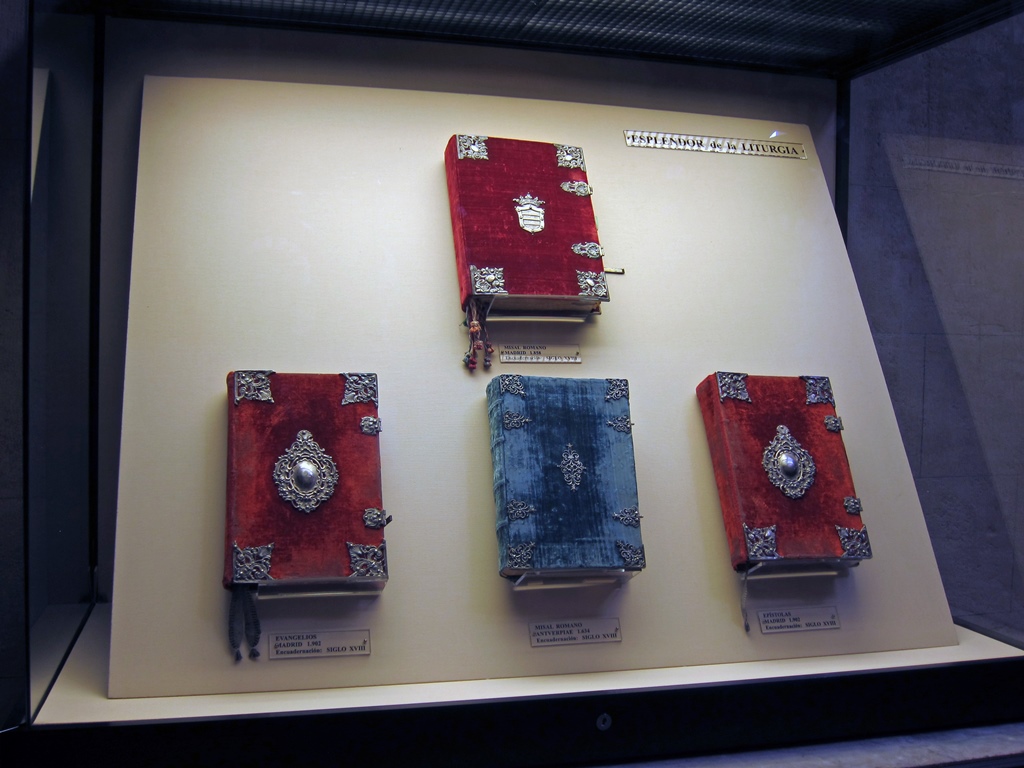
Bound Liturgical Volumes
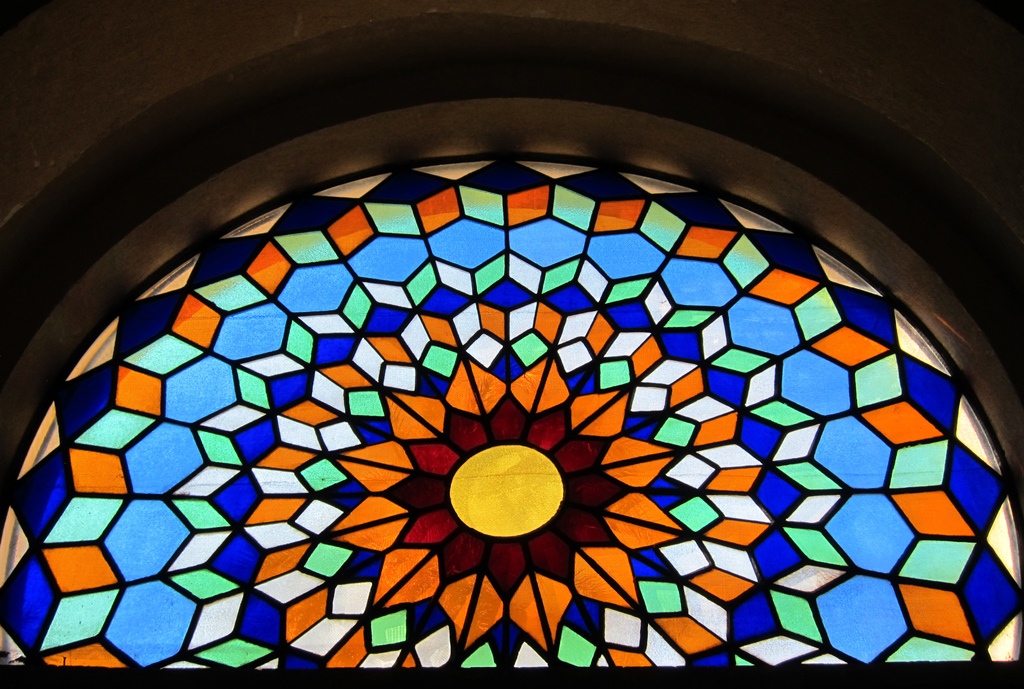
Stained Glass
Having had our fill of the Mezquita, we left as we had come in, through a doorway on
the west side of the courtyard. Across the street from the Mezquita we noted a building
with an impressive doorway. This building turned out to be the Palace of Congresses and
Exhibitions, first built as a hospital between 1512 and 1516 on the ruins of the old
Umayyad fortress. Apparently there is an impressive cloister inside, but they seemed to
be closed for the day.
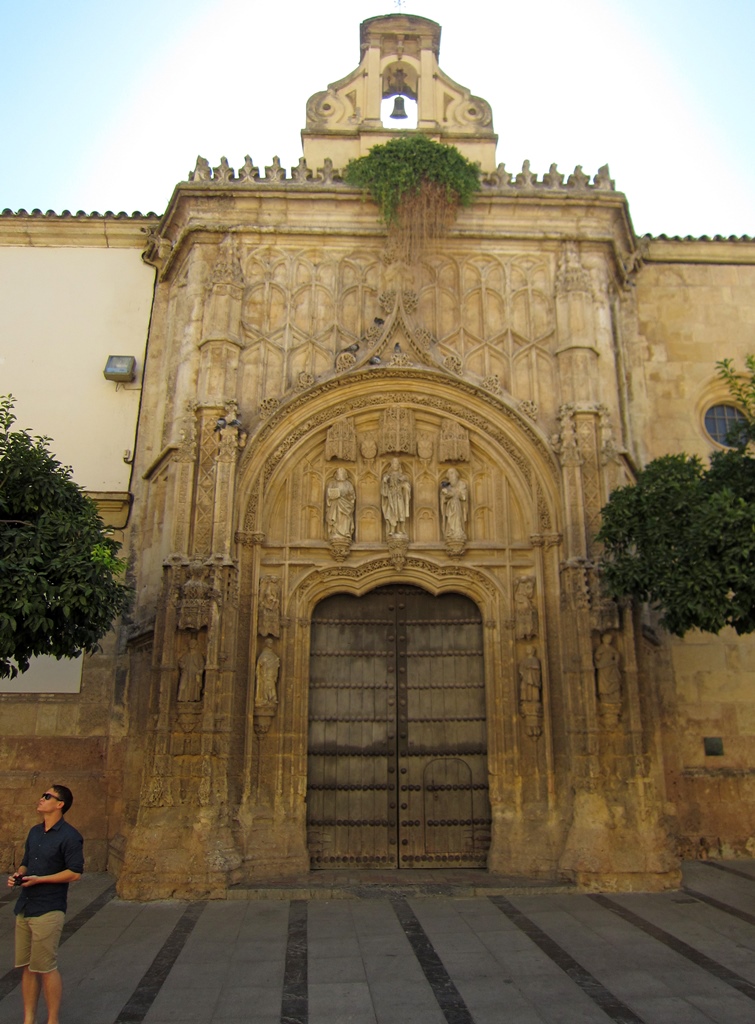
Philip and Palacio de Congresos y Exposiciones
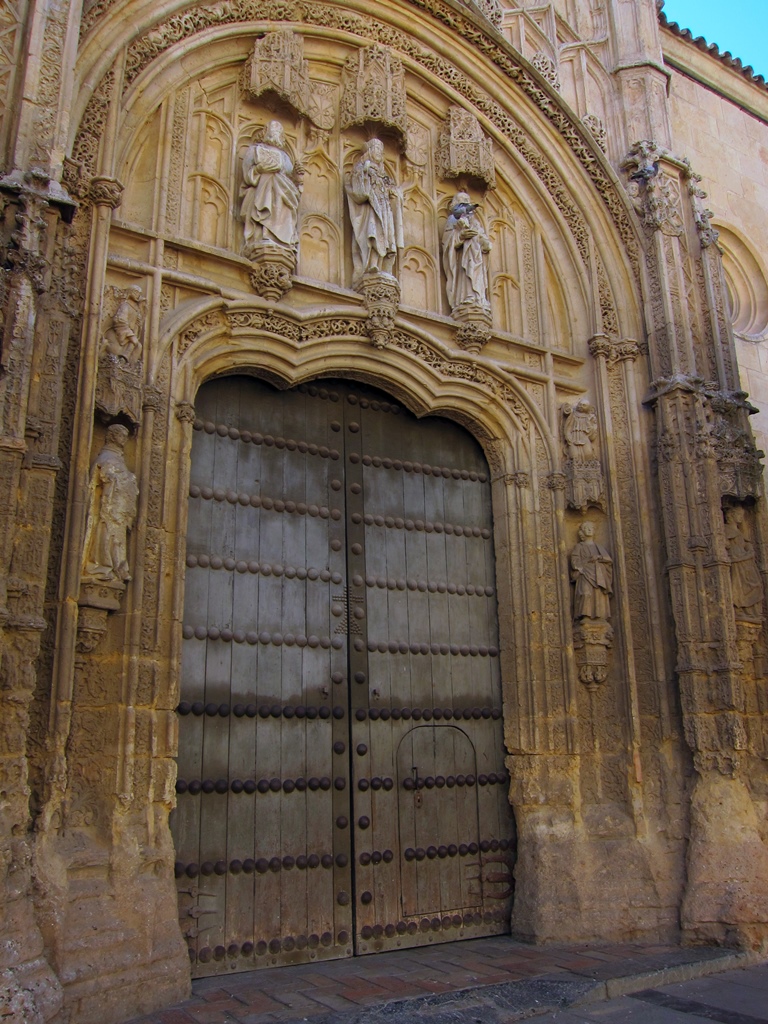
Doorway, Palacio de Congresos y Exposiciones
So we went looking for somewhere to eat dinner. This turned out to be at a place down
the street from the hotel, and turned out to be pretty good if I recall correctly. The
pictures reveal a long, breaded thing with French fries and a plate
stacked with large fried anchovies. While many people like anchovies on their pizza,
Nella likes anchovies on her anchovies, so she must have been thrilled when she saw
this on the menu.
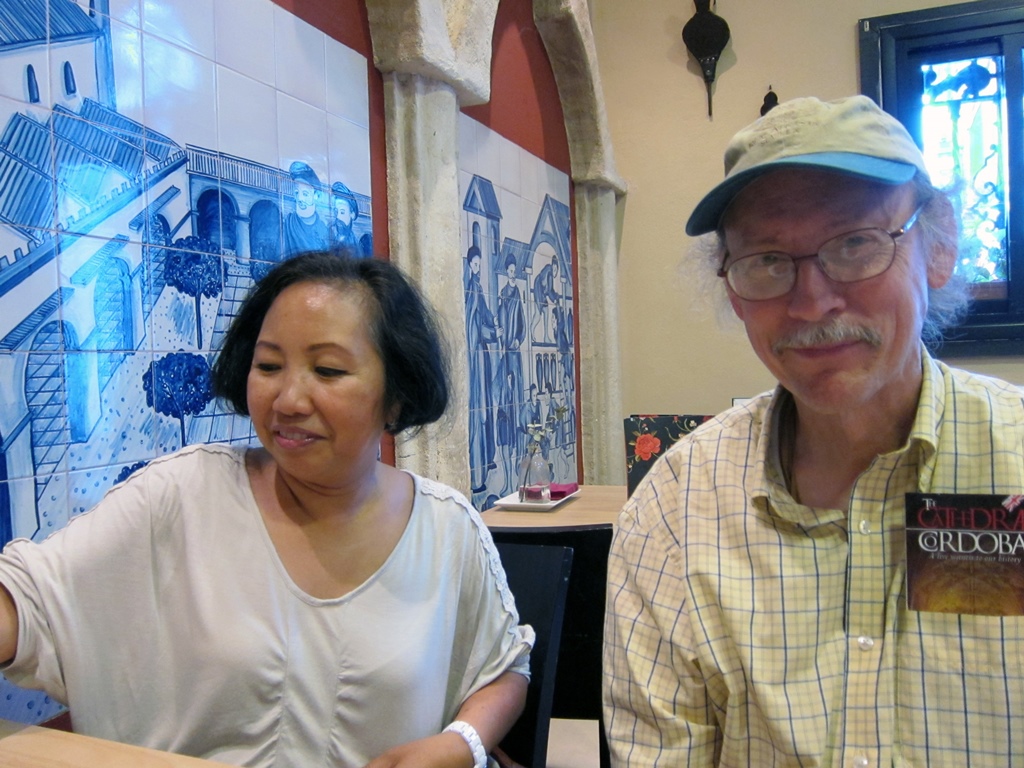
Nella and Bob at Dinner
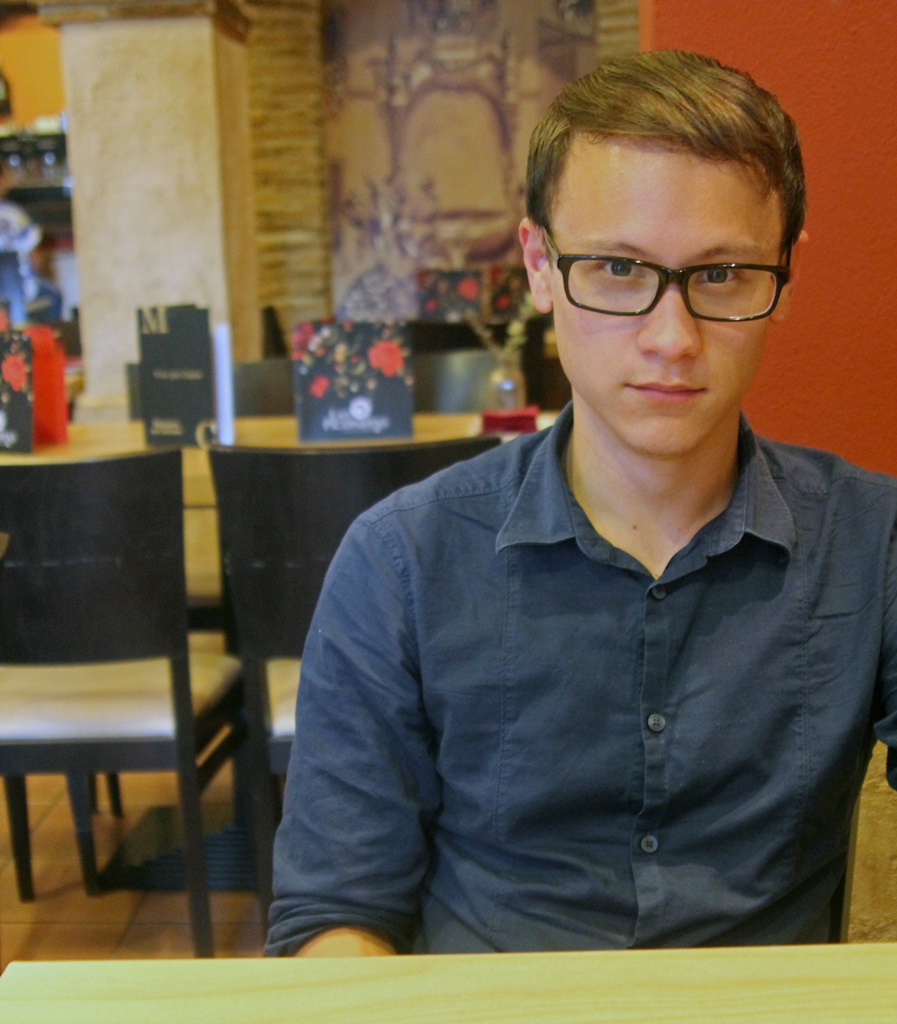
Philip at Dinner
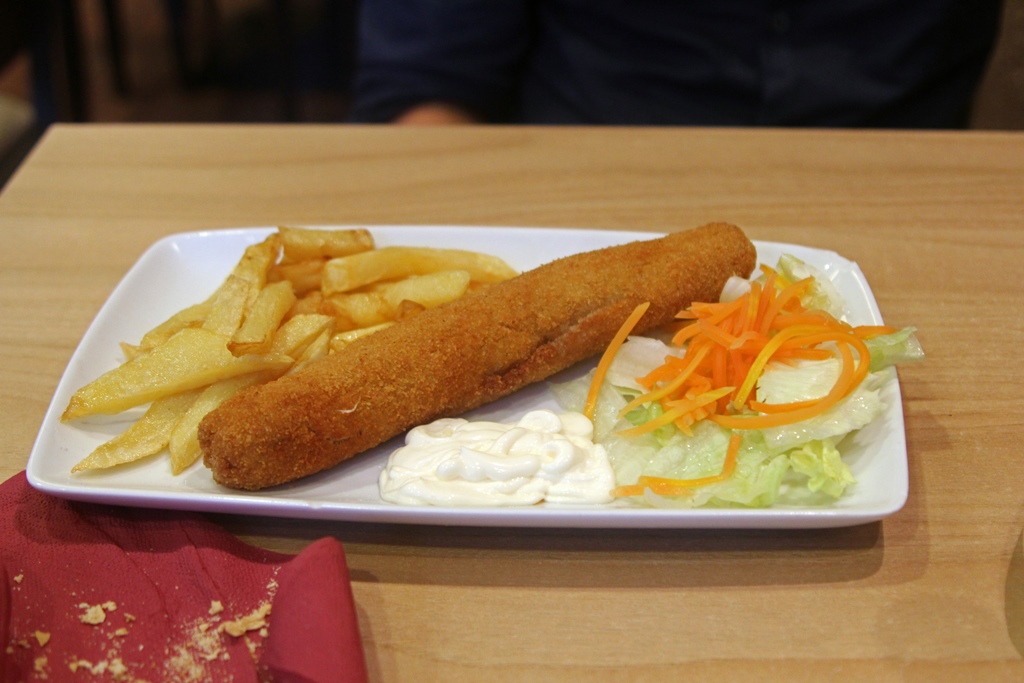
Breaded Object
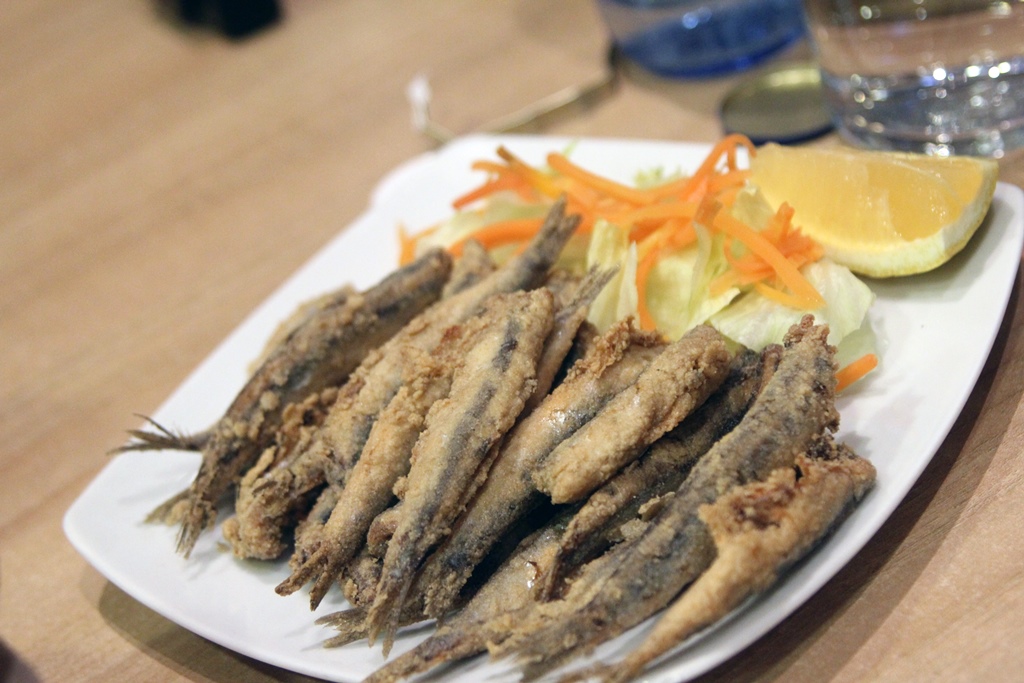
Anchovies
After dinner it was finally getting dark outside, so we took a short stroll to see
how well Córdoba did their mood lighting. Pretty well, as it turned out.
Mezquita Bell Tower
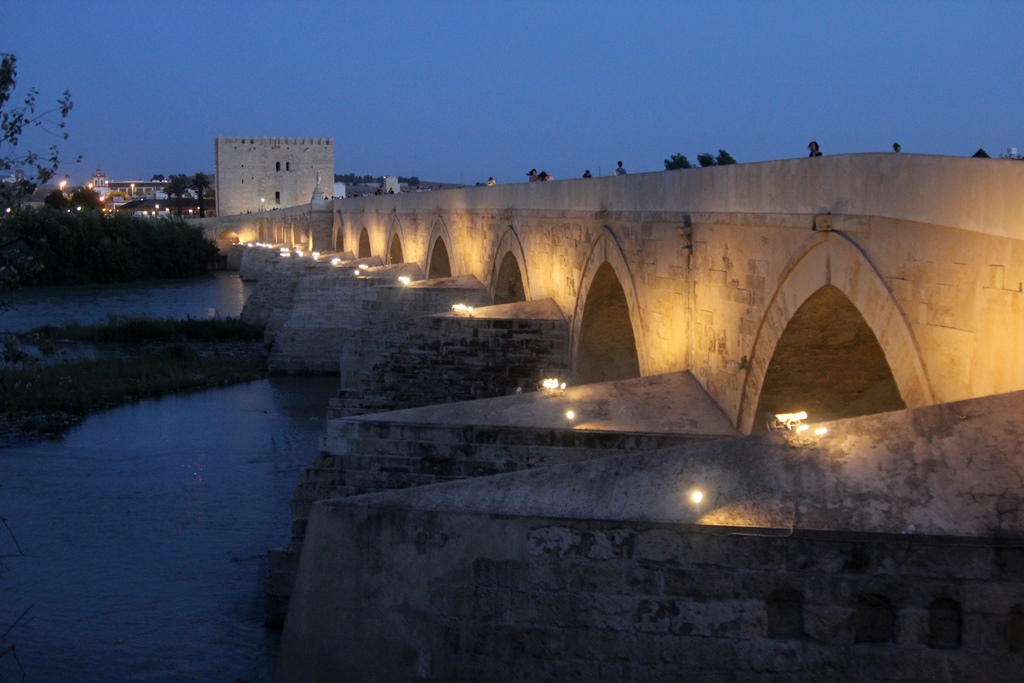
Roman Bridge
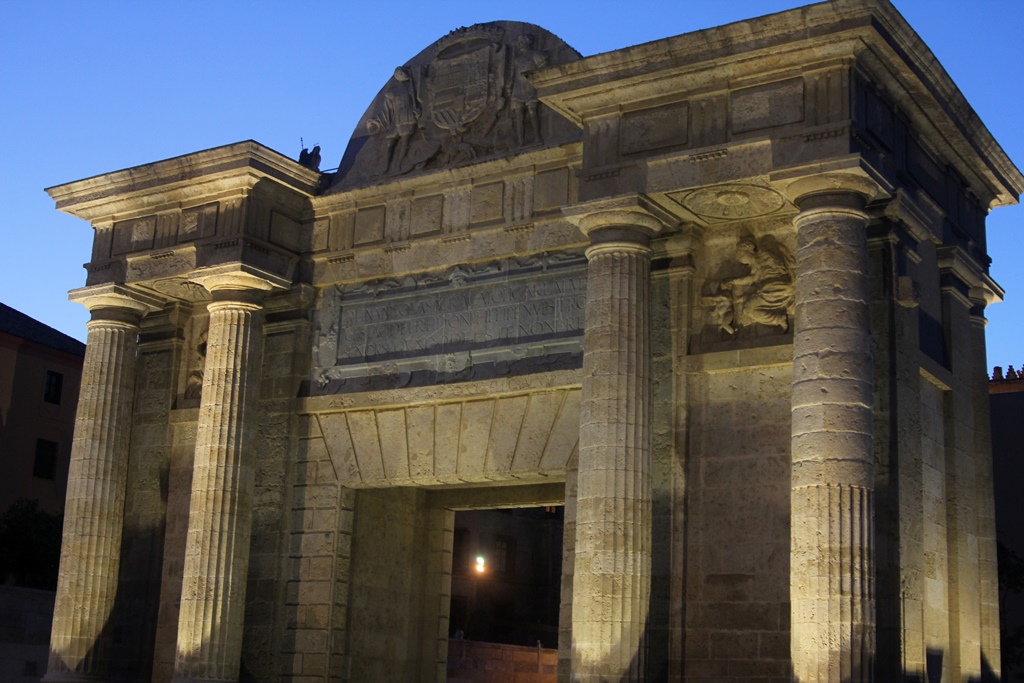
Puerta del Puente
Returning to the hotel, we unpacked enough to get us through the night. We were
only staying one night – the next morning we would be boarding a train to take
us back northward, to the city of Toledo.
























































